
Exhibit 99.1
Results for Announcement to the Market
James Hardie Industries N.V.
ARBN 097 829 895
1st Quarter Ended 30 June 2004
Net Sales |
up | 27 | % | to | US$ | 306.1M | ||||||||||
Operating Profit From Continuing Operations |
up | 13 | % | to | US$ | 37.1M | ||||||||||
Net Operating Profit including Discontinued Operations |
up | 5 | % | to | US$ | 36.3M | ||||||||||
Results for the 1st Quarter and three months ended 30 June 2004
Contents
| 1. | Media Release | |||
| 2. | Results At A Glance | |||
| 3. | Management’s Analysis of Results | |||
| 4. | Consolidated Financial Statements | |||
| 5. | Management Presentation | |||
The information contained in the above documents should be read in conjunction with the James Hardie 2004 Annual Report which can be found on the company website at www.jameshardie.com.
Incorporated in The Netherlands with corporate seat in Amsterdam. The liability of members is limited.
| media release | ||
| Analyst and Media enquiries about results, please contact Steve Ashe on | ||
| Tel: 61 2 8274 5246 | ||
| Mob: 0408 164 011 |
10 August 2004
1st Qtr Operating Profit from Continuing Operations1
US$37.1 million
Continued Strong Growth in USA Fibre Cement
James Hardie today announced an operating profit from continuing operations1 for the three months ended 30 June 2004 of US$37.1 million.
Among the 1st quarter highlights, total company net sales increased 27%, gross profit was up 25% and EBIT1 increased 21% to US$58.3 million.
The USA Fibre Cement business continued to grow strongly, lifting net sales 29% and EBIT1 17% compared to the same period a year ago.
Australia and New Zealand Fibre Cement increased net sales 18% and EBIT1 31% and the Philippines recorded another small positive EBIT1 for the quarter.
Diluted earnings per share from continuing operations increased 14% for the quarter, from US 7.1 cents to US 8.1 cents.
Net operating profit including discontinued operations1 of US$36.3 million incorporates US$0.8 million of additional costs associated with the sale of New Zealand land in March 2004. Costs associated with the NSW Commission of Inquiry into the Medical Research and Compensation Commission were US$2.9 million for the quarter.
1st Quarter at a Glance – US$ Million
| FY05 |
FY04 |
%+ \ (-) |
||||||||||
Net Sales |
306.1 | 241.5 | 27 | |||||||||
Gross Profit |
111.3 | 89.3 | 25 | |||||||||
Other Operating Expense |
2.9 | — | — | |||||||||
EBIT1 |
58.3 | 48.3 | 21 | |||||||||
Net Interest Expense |
(2.5 | ) | (2.3 | ) | 9 | |||||||
Income Tax Expense |
(18.7 | ) | (13.1 | ) | 43 | |||||||
Operating Profit from continuing operations1 |
37.1 | 32.9 | 13 | |||||||||
Net Operating Profit including discontinued operations1 |
36.3 | 34.7 | 5 | |||||||||
Unless otherwise stated, results are for continuing operations only and comparisons are of the 1st quarter of the current fiscal year versus the 1st quarter of the prior fiscal year.
Operations Commentary
James Hardie’s CEO, Peter Macdonald said: “The first quarter results represent a strong start to the year, and prospects for the balance of the year are encouraging.
“In our North American business, highlights included strong top line growth and margin expansion despite increased costs.
“Our growth rates in North America continued to accelerate and we again significantly outpaced the rate of housing construction growth.
“We expect to continue taking market share in both our emerging and established markets and in our exterior and interior product categories.
“The outlook for housing construction in North America remains positive.
“Our Asia Pacific businesses in Australia, New Zealand and the Philippines all delivered a stronger operating performance for the quarter,” Mr Macdonald said.
USA Fibre Cement – Strong Sales and Volume Growth
Net sales increased 29% to US$240.7 million in the 1st quarter due to a 27% increase in sales volume to 490.4 million square feet. The increase was due to continued penetration against substitute materials, including wood and vinyl siding, and a strong housing sector buoyed by low interest rates, strong house prices and a strengthening US economy.
Demand for the company’s products was strong in both our exterior and interior product categories and in our emerging and established markets.
Sales of higher-priced, differentiated products increased as a proportion of total sales, lifting the average net selling price by 2%.
Despite raw material cost increases in the 1st quarter, strong top line growth lifted EBIT1 17% to US$63.1 million for the quarter. The EBIT margin1 was 26.2% for the quarter.
Australia and New Zealand Fibre Cement
Net sales increased 18% to US$51.8 million for the quarter primarily due to stronger demand that lifted sales volumes 5%, and a favourable currency translation. New residential housing activity improved during the quarter led by buoyant activity in Queensland and the renovation and commercial segments remained strong. In New Zealand, new housing activity was robust.
EBIT1 increased 31% to US$11.0 million for the quarter and was up 18% in Australian dollars due to increased sales and cost savings. The EBIT margin1 for the quarter increased to 21.2%.
Philippines – Positive EBIT1
The Philippines business recorded another small positive EBIT1 in the quarter due to growth in higher-margin sales and cost reductions.
Chile – Positive EBIT1
The business recorded another quarterly positive EBIT1 as it continued to penetrate the domestic flat sheet market and reduce costs.
| Media Release: James Hardie – 1st Quarter Results FY05 | 2 |
USA Hardie® Pipe – Strong Growth and More Manufacturing Efficiencies
Operating performance was significantly improved as the business continued to grow sales and improve its manufacturing efficiency. Despite this, a small EBIT1 loss was incurred for the quarter.
Europe
Sales have continued to build steadily since commencement of operations in the same quarter last year. Increased awareness of our products among distributors, builders and contractors, and the addition of distribution outlets in the UK and French markets is generating stronger demand.
Income Tax Expense
The effective income tax rate for the quarter increased to 33.5% due to estimated income tax contingencies. We believe the effective income tax rate for the full fiscal year will be towards the upper end of our 25% to 30% expectation.
Special Commission of Inquiry
There is currently a Special Commission of Inquiry into the establishment of the Medical Research and Compensation Foundation in NSW, Australia. The company recently provided its submissions to the Inquiry and, on 14 July 2004, issued a statement announcing that it would recommend that shareholders approve the provision of additional funding to enable an effective statutory scheme to be established to compensate all future claimants for asbestos-related injuries caused by former James Hardie subsidiary companies. The Commission is expected to report to the NSW Government on 21 September 2004.
Outlook
In North America, the short-term outlook for housing construction remains positive. Interest rates remain low although they have started to increase, house prices are strong, inventories of new homes for sale are at an all-time low and consumer confidence is improving.
Indicators of future activity, including housing starts, permits and builder confidence, all remain at high levels.
The business expects to continue to generate strong top line growth and profitability as it further penetrates its exterior and interior product categories across its established and emerging markets.
In Australia and New Zealand, new housing construction is expected to soften in Australia but remain buoyant in the short term in New Zealand. The renovations and commercial segments are expected to remain relatively healthy. Further improvements to operating performance should result from more manufacturing efficiencies and cost savings. Negative sentiment associated with the Special Commission of Inquiry could have an adverse impact on Australian sales.
In the Philippines, improved domestic and regional economic conditions are expected to generate increased construction activity and demand for our products. Increased demand and cost savings should further improve operating performance.
Our Chilean business is in its seasonal slow-down period but further market penetration and share growth is expected as awareness of its expanded product range continues to grow. Both domestic and regional construction activity is continuing to show signs of improvement.
| Media Release: James Hardie – 1st Quarter Results FY05 | 3 |
In our USA Hardie® Pipe business, further improvements to operating performance are expected as it continues to increase production to meet growing demand in the southeast market, improve plant operating efficiency, and lower manufacturing costs.
In Europe, further market penetration and sales growth are expected as the business continues to build awareness of its products among builders, contractors and distributors.
The company believes the strong growth momentum evident in the first quarter will continue during the second quarter and the prospects for growth over the full year remain encouraging.
We are comfortable that the company’s operating profit from continuing operations1 for the 2005 fiscal year will fall within the current range of analyst estimates of between US$135 million and US$169 million*.
Ends.
Media/Analysts call:
Steve Ashe
Vice President Investor Relations
Telephone: 61 2 8274 5246
Mobile: 0408 164 011
Email: [email protected]
Facsimile: 61 2 8274 5218
The release and the accompanying management’s analysis of results and management presentation, along with the audio webcast of the presentation, are available from the Investor Relations section of the company website at www.jameshardie.com
This media release forms part of a package of information about the company’s results. It should be read in conjunction with the other parts of this package, including Management’s Analysis of Results, a Management Presentation, a Financial Report and a Results at a Glance document.
| * | Range includes forecasts from: ABN Amro, Deutsche, JPMorgan, Merrill Lynch, Goldman Sachs JBWere, UBS, Citigroup SB, Macquarie. |
| Media Release: James Hardie – 1st Quarter Results FY05 | 4 |
1Definitions
EBIT and EBIT Margin – EBIT is defined as operating income. EBIT margin is defined as EBIT as a percentage of our net sales. We believe EBIT and EBIT margin to be relevant and useful information as these are the primary measures used by our management to measure the operating profit or loss of our business. EBIT is one of several metrics used by our management to measure the cash generated from our operations, excluding the operating cash requirement of our interest and income taxes. Additionally, EBIT is believed to be a primary measure and terminology used by our Australian investors. EBIT and EBIT margin should be considered in addition to, but not as a substitute for, other measures of financial performance reported in accordance with accounting principles generally accepted in the United States of America. EBIT and EBIT margin, as we have defined them, may not be comparable to similarly titled measures reported by other companies.
EBIT and EBIT margin, as used in this document, are equivalent to the US GAAP measures of operating income and operating income margin.
Operating profit from continuing operations – is equivalent to the US GAAP measure of income from continuing operations.
Net operating profit including discontinued operations – is equivalent to the US GAAP measure of net income.
Disclaimer
This media release contains forward-looking statements.
Words such as “believe,” “anticipate,” “plan,” “expect,” “intend,” “target,” “estimate,” “project,” “predict,” “forecast,” “guideline,” “should,” “aim” and similar expressions are intended to identify forward-looking statements but are not the exclusive means of identifying such statements.
Forward-looking statements involve inherent risks and uncertainties. We caution you that a number of important factors could cause actual results to differ materially from the plans, objectives, expectations, estimates and intentions expressed in such forward-looking statements. These factors, which are further discussed in our reports submitted to the Securities and Exchange Commission on Forms 20-F and 6-K and in our other filings, include but are not limited to: competition and product pricing in the markets in which we operate; general economic and market conditions; compliance with and possible changes in environmental and health and safety laws; dependence on senior management; the success of our research and development efforts; the supply and cost of raw materials; our reliance on a small number of product distributors; the consequences of product failures or defects; exposure to environmental, asbestos or other legal proceedings; risks of conducting business internationally; changes in tax laws and treatments; and foreign exchange risks. We caution you that the foregoing list of factors is not exclusive and that other risks and uncertainties may cause actual results to differ materially from those in forward-looking statements. Forward-looking statements speak only as of the date they are made.
| Media Release: James Hardie – 1st Quarter Results FY05 | 5 |
Results at a Glance
1st Quarter Ended 30 June 2004
| 1st QTR FY05 | ||||||||||||
James Hardie |
||||||||||||
Net Sales |
Up | 27 | % | to | US$ | 306.1 | ||||||
EBIT1 |
Up | 21 | % | to | US$ | 58.3 | ||||||
Operating Profit1 |
Up | 13 | % | to | US$ | 37.1 | ||||||
Net Operating Profit
Including Discontinued
Operations1 |
Up | 5 | % | to | US$ | 36.3 | ||||||
EBIT Margin1 |
Down | 1.0 | pt | to | 19.0 | % | ||||||
USA Fibre Cement |
||||||||||||
Net Sales |
Up | 29 | % | to | US$ | 240.7 | ||||||
EBIT1 |
Up | 17 | % | to | US$ | 63.1 | ||||||
EBIT Margin1 |
Down | 2.8 | pts | to | 26.2 | % | ||||||
Volume |
Up | 27 | % | to | 490.4 | mmsf1 | ||||||
Asia Pacific Fibre Cement |
||||||||||||
Net Sales |
Up | 14 | % | to | US$ | 57.3 | ||||||
EBIT1 |
Up | 40 | % | to | US$ | 12.0 | ||||||
EBIT Margin1 |
Up | 3.7 | pts | to | 20.9 | % | ||||||
Volume |
Up | 8 | % | to | 94.2 | mmsf1 | ||||||
Key Ratios |
||||||||||||
Earnings Per Share (Diluted) |
8.1 | cents | ||||||||||
| EBIT Margin1 | 19.0 | % | ||||||||||
| Return on Shareholders Funds (Annualised – including discontinued operations) | 28.9 | % | ||||||||||
| Return on Capital Employed (Annualised) | 31.8 | % | ||||||||||
| Gearing ratio1 | 10.8 | % | ||||||||||
| Net Interest Cover (EBIT1 / Net interest expense) | 23.3 | x | ||||||||||
1Definitions
EBIT and EBIT Margin – EBIT is defined as operating income. EBIT margin is defined as EBIT as a percentage of our net sales. We believe EBIT and EBIT margin to be relevant and useful information as these are the primary measures used by our management to measure the operating profit or loss of our business. EBIT is one of several metrics used by our management to measure the cash generated from our operations, excluding the operating cash requirement of our interest and income taxes. Additionally, EBIT is believed to be a primary measure and terminology used by our Australian investors. EBIT and EBIT margin should be considered in addition to, but not as a substitute for, other measures of financial performance reported in accordance with accounting principles generally accepted in the United States of America. EBIT and EBIT margin, as we have defined them, may not be comparable to similarly titled measures reported by other companies.
EBIT and EBIT margin, as used in this document, are equivalent to the US GAAP measures of operating income and operating income margin.
Operating profit from continuing operations – is equivalent to the US GAAP measure of income from continuing operations.
Net operating profit including discontinued operations – is equivalent to the US GAAP measure of net income.
Gearing Ratio – is borrowings less cash (net debt) divided by net debt plus shareholders’ equity.
mmsf – million square feet
msf – thousand square feet
Management’s Analysis of Results
10 August 2004
|
Analyst and Media enquiries
about results, please contact Steve Ashe on |
|
| Tel: 61 2 8274 5246 | ||
| Mob: 0408 164 011 |
James Hardie Industries N.V.
Results for the 1st Quarter Ended 30 June 2004
| Three Months Ended 30 June |
||||||||||||
| USGAAP - US$ Millions |
FY 2005 |
FY 2004 |
% Change |
|||||||||
Net Sales |
||||||||||||
USA Fibre Cement |
$ | 240.7 | $ | 186.8 | 29 | |||||||
Asia Pacific Fibre Cement |
57.3 | 50.1 | 14 | |||||||||
Other Fibre Cement |
8.1 | 4.6 | 76 | |||||||||
Total Net Sales |
306.1 | 241.5 | 27 | |||||||||
Net sales |
$ | 306.1 | $ | 241.5 | 27 | |||||||
Cost of goods sold |
(194.8 | ) | (152.2 | ) | 28 | |||||||
Gross profit |
111.3 | 89.3 | 25 | |||||||||
Selling, general and administrative expenses |
(45.1 | ) | (36.2 | ) | 25 | |||||||
Research and development expenses |
(5.0 | ) | (4.8 | ) | 4 | |||||||
Other operating expense |
(2.9 | ) | — | — | ||||||||
EBIT 1 |
58.3 | 48.3 | 21 | |||||||||
Net interest expense |
(2.5 | ) | (2.3 | ) | 9 | |||||||
Operating profit from continuing operations before
income taxes 1 |
55.8 | 46.0 | 21 | |||||||||
Income tax expense |
(18.7 | ) | (13.1 | ) | 43 | |||||||
Operating Profit From Continuing Operations 1 |
$ | 37.1 | $ | 32.9 | 13 | |||||||
Net Operating Profit Including Discontinued
Operations 1 |
$ | 36.3 | $ | 34.7 | 5 | |||||||
Effective tax rate from continuing operations |
33.5 | % | 28.5 | % | ||||||||
Volume (mmsf1) |
||||||||||||
USA Fibre Cement |
490.4 | 387.5 | 27 | |||||||||
Asia Pacific Fibre Cement * |
94.2 | 87.0 | 8 | |||||||||
Average net sales price per unit (per msf1) |
||||||||||||
USA Fibre Cement |
US$ | 491 | US$ | 482 | 2 | |||||||
Asia Pacific Fibre Cement * |
A$ | 851 | A$ | 874 | (3 | ) | ||||||
* See Endnotes
Total Net Sales
Total net sales increased 27% compared to the same quarter of the previous year, from US$241.5 million to US$306.1 million.
Net sales from USA Fibre Cement increased 29% from US$186.8 million to US$240.7 million due to continued strong growth in sales volumes and a higher average net selling price.
Net sales from Asia Pacific Fibre Cement increased 14% from US$50.1 million to US$57.3 million due to increased sales volumes and favourable currency exchange rate differences.
Net sales from Other Fibre Cement increased 76% from US$4.6 million to US$8.1 million as the Chilean flat sheet business, the USA-based Hardie® Pipe business and European Fibre Cement business continued to grow.
USA Fibre Cement
Net sales increased 29% from US$186.8 million to US$240.7 million due to increased sales volumes and a higher average net selling price.
Sales volume increased 27% from 387.5 million square feet to 490.4 million square feet, primarily due to continued strong growth in primary demand for fibre cement and a favourable housing construction market.
New residential housing construction remained buoyant during the quarter due to strong consumer demand and low inventories of houses for sale, fuelled by low interest rates, solid house prices and a strengthening domestic economy.
We continued to grow sales in both our emerging and established geographic markets and in our exterior and interior product markets.
Further market share was gained in our emerging markets as our exterior products continued to penetrate against alternative materials, primarily wood-based and vinyl siding. There continued to be growth in sales of higher-priced, differentiated products such as vented soffits, Heritage® panels, the ColorPlus™ Collection of pre-painted siding and Harditrim® XLD™.
There were further market share gains in the interior products market, with sales of Hardibacker 500® half-inch backerboard up strongly compared to the same period last year.
The average net selling price increased 2% from US$482 per thousand square feet to US$491 per thousand square feet. The increase was due to proportionally stronger growth of differentiated, higher priced products including Harditrim®, vented soffit and the ColorPlus™ Collection. A price increase was announced for some products at the end of the first fiscal quarter.
During the quarter, we continued construction of our new green-field fibre cement plant in Reno, Nevada and our new 160 million square foot trim line in Peru, Illinois.
Asia Pacific Fibre Cement (See Endnotes)
Net sales for this segment increased 14% from US$50.1 million to US$57.3 million. Net sales increased 3% in Australian dollars. Sales volume increased 8% from 87.0 million square feet to 94.2 million square feet.
| James Hardie 1st Quarter FY05 Management’s Analysis of Results | 2 |
Australia and New Zealand Fibre Cement
Net sales increased 18.0% from US$43.9 million to US$51.8 million due to increased sales volume and a favourable currency exchange rate difference. In Australian dollars, net sales increased 6%.
Sales volumes increased 5% from 69.8 million square feet to 73.1 million square feet due to growth in sales of building products in both Australia and New Zealand.
In Australia, new residential housing activity improved during the quarter led by buoyant activity in Queensland, and the renovation and commercial segments remained strong.
In New Zealand, new residential housing activity was robust and there was increased demand for weatherboards, eaves and soffits. Sales of our Linea® range of weatherboards continued to grow strongly.
The average net selling price increased 1% in Australian dollars due to a change in sales mix.
During the quarter, we launched Eclipsa™, a new pre-painted eave product, across Australia. Eclipsa™ offers cost benefits and construction advantages over non-painted eave products and we expect it to be received favourably by builders.
Philippines Fibre Cement
Net sales increased 15% from US$4.8 million to US$5.5 million. In local currency, net sales increased 21%. This increase was due to a 23% increase in volume partially offset by a 1% decrease in the average net selling price.
The decline in the net selling price was due mainly to a change in sales mix between domestic and export sales.
Improved construction activity in the Philippines and increased market penetration resulted in stronger demand during the quarter.
Other Fibre Cement
Chile Fibre Cement
Our Chilean business continued to penetrate the domestic flat sheet market during the quarter. Sales volume increased compared to the same quarter last year due to stronger domestic demand, partly offset by reduced exports to North America.
Despite increased sales volume, net sales were lower than the same period last year due mainly to a lower average net selling price compared to the same period last year. The lower average net selling price was due to a higher mix of domestic sales and the impact of a weaker US dollar on export sales.
Construction activity in Chile was weaker during the quarter due to the slower winter season, but continued to show ongoing signs of improvement.
| James Hardie 1st Quarter FY05 Management’s Analysis of Results | 3 |
Hardie® Pipe
Our USA Hardie® Pipe business continued to penetrate the Florida market of the United States and improve its manufacturing efficiency.
Net sales increased strongly compared to the same period last year due to a near doubling in sales volume and a higher average net selling price. The increase in sales volume was due to market share gains and buoyant construction activity in Florida.
The average net selling price increased compared to the same period last year, but prices in Florida remain well below the national averages for concrete pipe. The lower prices continue to reflect the competitive response to our entry into the southeast market.
The manufacturing performance of the plant improved further during the quarter, but operating costs are still above our targets.
Europe
Our European business continued to grow demand by building awareness of our products among distributors, builders and contractors, and by adding further distribution outlets in both the UK and French markets.
Sales have continued to build steadily since commencement of operations in the first quarter of the previous fiscal year. Net sales this quarter increased 56% compared to the previous quarter ended 31 March 2004, due to stronger demand across the range of interior and exterior products.
Artisan® Roofing
In June 2003, we began to commission and trial our pilot roofing plant in Fontana, California. The pilot plant, which has a design capacity of 25 mmsf, was built to test our proprietary manufacturing technology and to provide product for market testing in Southern California.
Further production trials and commissioning work were completed during the quarter. Sales are expected to ramp-up throughout the remainder of the fiscal year.
Initial pricing of our Artisan® Roofing product is positioned to be competitive with wood shake roofing products in Southern California.
Preliminary interest in Artisan® Roofing within our targeted customer group remains strong.
Gross Profit
Gross profit increased 25% from US$89.3 million to US$111.3 million due to improvements in our major businesses. The gross profit margin decreased 0.6 of a percentage point to 36.4%.
USA Fibre Cement gross profit increased 21% due to higher net sales, partly offset by an increase in unit cost of sales and increased freight costs. The higher unit cost of sales resulted primarily from increased sales of higher-priced, differentiated products, higher pulp and cement costs, maintenance expenses and general liability insurance. The gross profit margin decreased 2.3 percentage points.
Asia Pacific Fibre Cement gross profit increased 28% following significant improvements from Australia and New Zealand Fibre Cement and Philippines Fibre Cement, which increased 26% and 58% respectively. The improved result for Australia and New Zealand was due to increased sales revenue and manufacturing efficiency improvements across all plants. In the Philippines, lower costs and
| James Hardie 1st Quarter FY05 Management’s Analysis of Results | 4 |
increased margins accounted for the stronger gross profit performance. The Asia Pacific Fibre Cement gross profit margin increased 3.9 percentage points.
Selling, General and Administrative (SG&A) Expenses
SG&A expenses increased 25% compared to the same quarter last year, from US$36.2 million to US$45.1 million. The increase in SG&A expenses was due mainly to increased sales and marketing, information technology and human resource expenses associated with growth initiatives in the United States. As a percentage of sales, SG&A expenses were 0.3 of a percentage point lower at 14.7%.
Research and Development Expenses
Research and development expenses include costs associated with “core” research projects that are designed to benefit all fibre cement business units. These costs are recorded in the Research and Development segment rather than being attributed to individual business units. These costs increased 7% for the quarter to US$2.9 million.
Other research and development costs associated with commercialisation projects in business units are included in the business related unit segment results. In total, these costs were flat at US$2.1 million.
Other Operating Expense
Other operating expense of US$2.9 million is attributable to expenses related to the NSW Government Special Commission of Inquiry into the Medical Research and Compensation Foundation.
EBIT1
EBIT increased 21% from US$48.3 million to US$58.3 million. The EBIT margin decreased 1.0 percentage point to 19.0%.
USA Fibre Cement EBIT increased 17% from US$54.1 million to US$63.1 million. The increase was due to strong growth in net sales, partly offset by an increase in both unit cost of sales and unit freight cost, and SG&A expenses. The increase in unit cost of sales was primarily from increased sales of higher cost differentiated products, higher pulp and cement costs, increased maintenance expenses and increased general liability insurance. The EBIT margin decreased 2.8 percentage points to 26.2%, but increased 2.9 percentage points compared to the fourth quarter of the previous fiscal year.
Asia Pacific Fibre Cement EBIT increased 40% from US$8.6 million to US$12.0 million. The EBIT margin increased 3.7 percentage points to 20.9%.
Australia and New Zealand Fibre Cement EBIT increased 31% from US$8.4 million to US$11.0 million. In Australian dollars, EBIT increased 18%. The increase in EBIT in Australian dollars was due to increased net sales compared to the same period last year and manufacturing efficiencies. The EBIT margin increased 2.1 percentage points to 21.2%.
Philippines Fibre Cement business increased US$0.7 million to US$1.0 million for the quarter due to cost savings and higher margins.
The Chile Fibre Cement business recorded another small positive EBIT for the quarter due to lower costs, partly offset by a decrease in net sales.
Our USA Hardie® Pipe business incurred a small EBIT loss for the quarter despite a significant improvement in operating performance.
| James Hardie 1st Quarter FY05 Management’s Analysis of Results | 5 |
Our European fibre cement business incurred an EBIT loss for the quarter, following its commencement in the prior fiscal year.
General corporate costs increased US$2.0 million from US$7.4 million to US$9.4 million. This increase was primarily due to legal expenses related to the Special Commission of Inquiry into the Medical Research and Compensation Committee, a net increase in professional service fees and other general corporate expenses of US$1.0 million, partially offset by a US$1.9 million decrease in employee share based compensation expense from stock appreciation rights primarily caused by a decrease in the company’s share price.
Net Interest Expense
Net interest expense increased by US$0.2 million from US$2.3 million to US$2.5 million primarily due to a higher amount of interest expense capitalised in the prior year than the current year.
Income Tax Expense
Income tax expense increased by US$5.6 million from US$13.1 million to US$18.7 million due to the increase in profit and estimated income tax contingencies recorded during the period. Although the tax rate in this quarter was 33.5%, we anticipate that our effective income tax rate for the full fiscal year will be towards the upper end of our 25% to 30% expectation.
Operating Profit from Continuing Operations1
Operating profit from continuing operations increased by 13%, from US$32.9 million to US$37.1 million, due to stronger performance from our major businesses.
Discontinued Operations
Net expense of US$0.8 million relates to additional costs associated with the sale of New Zealand land in March 2004.
Liquidity and Capital Resources
We have historically met our working capital needs and capital expenditure requirements through a combination of cash flow from operations, proceeds from the divestiture of businesses, credit facilities and other borrowings, proceeds from the sale of property, plant and equipment and proceeds from the redemption of investments. Seasonal fluctuations in working capital generally have not had a significant impact on our short-term or long-term liquidity. We believe that we can meet our present working capital requirements for at least the next 12 months based on our current capital resources.
We had cash and cash equivalents of US$112.9 million as of 30 June 2004. At that date we also had credit facilities totalling US$431.8 million of which US$175.5 million was outstanding. Our credit facilities are all uncollateralised and consist of the following:
| James Hardie 1st Quarter FY05 Management’s Analysis of Results | 6 |
| Effective | Principal | |||||||||||
| Interest Rate | Total Facility | Outstanding | ||||||||||
| at | at | at | ||||||||||
| Description |
30 June 2004 |
30 June 2004 |
30 June 2004 |
|||||||||
| (US$ millions) | ||||||||||||
US$ notes; fixed interest; repayable annually in varying
tranches from November 2004 through November 2013 |
7.09 | % | $ | 165.0 | $ | 165.0 | ||||||
A$ revolving loan; can be drawn down in either US$ or
A$; variable interest based on US$ LIBOR or A$ bank bill
rate plus margin; can be repaid and redrawn until
maturity in November 2006 |
N/A | 137.8 | — | |||||||||
US$ stand-by loan; can be drawn down in either US$ or
A$; variable interest based on US$ LIBOR or A$ bank bill
rate plus margin until maturity in April 2005 |
N/A | 117.5 | — | |||||||||
US$ line of credit; can be drawn down in Chilean Pesos;
variable interest based on Chilean Tasa Activa Bancaria
rate plus margin until maturity in October and December
2004 |
3.52 | % | 11.5 | 10.5 | ||||||||
Total |
$ | 431.8 | $ | 175.5 | ||||||||
Cash Flow
Net operating cash inflows increased by US$40.0 million during the quarter from US$31.0 to US$71.0 million. Net income, after adjusting for the gain on disposal of subsidiaries and businesses, increased by US$3.4 million. Adjusting further for non-cash items included in net income, cash flows from operations increased additionally by US$7.2 million. Other working capital changes caused a net increase in cash of US$29.4 million.
Net investing activities produced a cash outflow of US$30.3 million during the quarter compared to US$14.6 million in the prior year quarter. The increase in the cash outflow was primarily due to additional capital expenditures of US$10.5 million in the current quarter and US$5.0 million cash received in the prior year quarter from the sales of our New Zealand Building Systems in May 2003 that did not recur in the current quarter.
Net financing activities resulted in an inflow of US$0.4 million for the quarter compared to US$1.7 million in the prior year quarter. The decrease was primarily due to proceeds from borrowings of US$1.0 million in the prior year quarter that did not recur this quarter.
| James Hardie 1st Quarter FY05 Management’s Analysis of Results | 7 |
Special Commission of Inquiry
The Special Commission of Inquiry (the “SCI”) into the Medical Research and Compensation Foundation has been hearing evidence since 5 April 2004 and oral submissions commenced on 4 August 2004. The SCI is expected to report by 21 September 2004.
On 14 July 2004, the company lodged a submission with the SCI stating that the company would recommend that shareholders approve the provision of additional funding to enable an effective statutory scheme to compensate all future claimants for asbestos-related injuries caused by former James Hardie subsidiary companies. The company proposed that the statutory scheme include the following elements:
| • | Speedy, fair and equitable compensation for all existing and future claimants, including objective criteria to reduce superimposed (judicial) inflation; | |||
| • | contributions to be made in a manner which provides certainty to claimants as to their entitlements, the scheme administrator as to the amount available for distribution, and the contributors as to the ultimate amount of the contribution to the scheme; | |||
| • | significant reduction in legal costs via the removal of requirements for litigation; and | |||
| • | limitation of legal avenues outside of the scheme. | |||
The submission stated that the proposal was made without any admission of liability or prejudice to the company’s rights or defences.
While it is not possible to predict outcomes of the SCI, it is possible that the SCI will make adverse findings against the company and ABN 60 which in turn could form the basis of legal claims against the company. It is not possible to determine whether the SCI will adopt the company’s scheme recommendations, whether such a scheme would be accepted by the NSW government nor whether shareholders would resolve to contribute to the scheme. The company has incurred substantial costs associated with the SCI and may incur material costs in the future related to the SCI or subsequent legal proceedings.
End.
Media/Analysts call:
Steve Ashe
Vice President Investor Relations
Telephone: 61 2 8274 5246
Mobile: 0408 164 011
Email: [email protected]
Facsimile: 61 2 8274 5218
The Management’s Analysis of Results and accompanying release and management presentation, along with an audio webcast of the presentation, will be available from the Investor Relations website at www.jameshardie.com
This Management’s Analysis of Results document forms part of a package of information about the company’s results. It should be read in conjunction with the other parts of this package, including a Media Release, a Management Presentation, a Financial Report and a Results at a Glance document.
| James Hardie 1st Quarter FY05 Management’s Analysis of Results | 8 |
Endnotes:
Volume and Average Net Selling Price – Asia Pacific Fibre Cement – Adjusted:
In fiscal 2003 and 2004, our Asia Pacific Fibre Cement segment reported incorrect volume figures due to errors when converting to our standard square feet metric and due to our Philippines Fibre Cement business including intercompany volume during fiscal 2004. The following table presents adjusted volume and average net selling price for our Asia Pacific Fibre Cement business segment. This Management’s Analysis of Results uses these revised volume and average net selling price.
| Fiscal 2003 | 30 | 31 | ||||||||||||||
| 30 June | September | December | 31 March | |||||||||||||
| Quarter | 2002 | 2002 | 2002 | 2003 | ||||||||||||
Volume (mmsf1) |
83.1 | 90.6 | 88.7 | 87.5 | ||||||||||||
Average net sales
price per unit (per
msf1) |
A$888 | A$905 | A$898 | A$857 | ||||||||||||
Year-to-date |
||||||||||||||||
Volume (mmsf1) |
83.1 | 173.7 | 262.4 | 349.9 | ||||||||||||
Average net sales
price per unit (per
msf1) |
A$888 | A$897 | A$897 | A$887 | ||||||||||||
| Fiscal 2004 | 30 | 31 | ||||||||||||||
| 30 June | September | December | 31 March | |||||||||||||
| Quarter | 2003 | 2003 | 2003 | 2004 | ||||||||||||
Volume (mmsf1) |
87.0 | 94.0 | 92.1 | 89.0 | ||||||||||||
Average net sales
price per unit (per
msf1) |
A$874 | A$865 | A$854 | A$854 | ||||||||||||
Year-to-date |
||||||||||||||||
Volume (mmsf1) |
87.0 | 181.0 | 273.1 | 362.1 | ||||||||||||
Average net sales
price per unit (per
msf1) |
A$874 | A$869 | A$864 | A$862 | ||||||||||||
Net Sales – Philippines Fibre Cement – Adjusted:
In the fiscal 2004, our Philippines business incorrectly reported intercompany transfers as external net sales and cost of sales. Adjustment to the Philippines Fibre Cement discussion is necessary to provide an accurate quarter-to-quarter discussion of Philippines Fibre Cement net sales. Therefore, for discussion purposes only for the Philippines Fibre Cement business, we adjusted the prior year Philippines Fibre Cement net sales. We have not restated the Asia Pacific Fibre Cement business segment results or the consolidated financial statements since these adjustments are not material to our Asia Pacific Fibre Cement segment or to the consolidated financial statements taken as a whole. The following table presents the adjustment to Philippines Fibre Cement net sales for each quarter and year-to-date periods in fiscal 2004:
| 30 | 31 | |||||||||||||||
| 30 June | September | December | 31 March | |||||||||||||
| 2003 | 2003 | 2003 | 2004 | |||||||||||||
Quarters: |
||||||||||||||||
Previously Reported |
US$6.2 | US$6.9 | US$5.2 | US$5.9 | ||||||||||||
Adjustment |
(1.4) | (1.2) | - | (0.8) | ||||||||||||
Adjusted Net Sales |
US$4.8 | US$5.7 | US$5.2 | US$5.1 | ||||||||||||
Year to date: |
||||||||||||||||
Previously Reported |
US$6.2 | US$13.1 | US$18.3 | US$24.2 | ||||||||||||
Adjustment |
(1.4) | (2.6) | (2.6) | (3.4) | ||||||||||||
Adjusted Net Sales
|
US$4.8 | US$10.5 | US$15.7 | US$20.8 | ||||||||||||
| James Hardie 1st Quarter FY05 Management’s Analysis of Results | 9 |
1Definitions
EBIT and EBIT Margin – EBIT is defined as operating income. EBIT margin is defined as EBIT as a percentage of our net sales. We believe EBIT and EBIT margin to be relevant and useful information as these are the primary measures used by our management to measure the operating profit or loss of our business. EBIT is one of several metrics used by our management to measure the cash generated from our operations, excluding the operating cash requirement of our interest and income taxes. Additionally, EBIT is believed to be a primary measure and terminology used by our Australian investors. EBIT and EBIT margin should be considered in addition to, but not as a substitute for, other measures of financial performance reported in accordance with accounting principles generally accepted in the United States of America. EBIT and EBIT margin, as we have defined them, may not be comparable to similarly titled measures reported by other companies.
EBIT and EBIT margin, as used in this document, are equivalent to the US GAAP measures of operating income and operating income margin.
Operating profit from continuing operations before income taxes – is equivalent to the US GAAP measure of income from continuing operations before income taxes.
Operating profit from continuing operations – is equivalent to the US GAAP measure of income from continuing operations.
Net operating profit including discontinued operations – is equivalent to the US GAAP measure of net income.
mmsf – million square feet
msf – thousand square feet
Disclaimer
This Management’s Analysis of Results contains forward-looking statements.
Words such as “believe,” “anticipate,” “plan,” “expect,” “intend,” “target,” “estimate,” “project,” “predict,” “forecast,” “guideline,” “should,” “aim” and similar expressions are intended to identify forward-looking statements but are not the exclusive means of identifying such statements.
Forward-looking statements involve inherent risks and uncertainties. We caution you that a number of important factors could cause actual results to differ materially from the plans, objectives, expectations, estimates and intentions expressed in such forward-looking statements. These factors, which are further discussed in our reports submitted to the Securities and Exchange Commission on Forms 20-F and 6-K and in our other filings, include but are not limited to: competition and product pricing in the markets in which we operate; general economic and market conditions; compliance with and possible changes in environmental and health and safety laws; dependence on senior management; the success of our research and development efforts; the supply and cost of raw materials; our reliance on a small number of product distributors; the consequences of product failures or defects; exposure to environmental, asbestos or other legal proceedings; risks of conducting business internationally; changes in tax laws and treatments; and foreign exchange risks. We caution you that the foregoing list of factors is not exclusive and that other risks and uncertainties may cause actual results to differ materially from those in forward-looking statements. Forward-looking statements speak only as of the date they are made.
| James Hardie 1st Quarter FY05 Management’s Analysis of Results | 10 |
INDEX
Item 1. Financial Statements
JAMES HARDIE INDUSTRIES N.V. AND SUBSIDIARIES
| (Millions of US dollars) |
(Millions of Australian dollars) |
|||||||||||||||
| 30 June | 31 March | 30 June | 31 March | |||||||||||||
| 2004 |
2004 |
2004 |
2004 |
|||||||||||||
| (Unaudited) | (Unaudited) | (Unaudited) | ||||||||||||||
ASSETS |
||||||||||||||||
Current assets: |
||||||||||||||||
Cash and cash equivalents |
$ | 112.9 | $ | 72.3 | A$ | 163.8 | A$ | 95.1 | ||||||||
Accounts and notes receivable, net of allowance for
doubtful accounts of $1.2 million (A$1.7 million) and
$1.2 million (A$1.6 million) as of 30 June 2004 and
31 March 2004, respectively |
117.2 | 118.4 | 170.1 | 155.8 | ||||||||||||
Inventories |
91.3 | 103.2 | 132.5 | 135.8 | ||||||||||||
Refundable income taxes |
1.6 | 37.8 | 2.3 | 49.7 | ||||||||||||
Prepaid expenses and other current assets |
11.8 | 8.8 | 17.1 | 11.6 | ||||||||||||
Deferred tax assets |
27.6 | 24.7 | 40.0 | 32.5 | ||||||||||||
Total current assets |
362.4 | 365.2 | 525.8 | 480.5 | ||||||||||||
Long-term receivables and other assets |
7.3 | 9.8 | 10.6 | 12.9 | ||||||||||||
Property, plant and equipment, net |
584.8 | 567.1 | 848.5 | 746.1 | ||||||||||||
Intangible assets, net |
3.0 | 3.0 | 4.4 | 3.9 | ||||||||||||
Prepaid pension cost |
12.9 | 14.1 | 18.7 | 18.5 | ||||||||||||
Deferred tax assets |
11.3 | 12.0 | 16.4 | 15.8 | ||||||||||||
Total assets |
$ | 981.7 | $ | 971.2 | A$ | 1,424.4 | A$ | 1,277.7 | ||||||||
LIABILITIES AND SHAREHOLDERS’ EQUITY |
||||||||||||||||
Current liabilities: |
||||||||||||||||
Accounts payable and accrued liabilities |
$ | 86.5 | $ | 78.5 | A$ | 125.5 | A$ | 103.3 | ||||||||
Current portion of long-term debt |
17.6 | 17.6 | 25.5 | 23.2 | ||||||||||||
Short-term debt |
10.5 | 10.8 | 15.2 | 14.2 | ||||||||||||
Dividends payable |
13.7 | — | 19.9 | — | ||||||||||||
Accrued payroll and employee benefits |
29.6 | 41.1 | 42.9 | 54.1 | ||||||||||||
Accrued product warranties |
9.0 | 9.7 | 13.1 | 12.8 | ||||||||||||
Income taxes payable |
13.1 | 9.8 | 19.0 | 12.9 | ||||||||||||
Other liabilities |
1.7 | 1.8 | 2.5 | 2.4 | ||||||||||||
Total current liabilities |
181.7 | 169.3 | 263.6 | 222.9 | ||||||||||||
Long-term debt |
147.4 | 147.4 | 213.9 | 193.9 | ||||||||||||
Deferred income taxes |
68.0 | 65.2 | 98.7 | 85.8 | ||||||||||||
Accrued product warranties |
2.8 | 2.3 | 4.1 | 3.0 | ||||||||||||
Other liabilities |
64.6 | 82.3 | 93.7 | 108.3 | ||||||||||||
Total liabilities |
464.5 | 466.5 | A$ | 674.0 | A$ | 613.9 | ||||||||||
Commitments and contingencies (Note 9) |
||||||||||||||||
Shareholders’ equity: |
||||||||||||||||
Common stock, Euro 0.59 par value, 2.0 billion shares
authorised; 458,706,017 shares issued and
outstanding at 30 June 2004 and 458,558,436
shares issued and outstanding at 31 March 2004 |
245.3 | 245.2 | ||||||||||||||
Additional paid-in capital |
135.0 | 134.0 | ||||||||||||||
Retained earnings |
173.7 | 151.1 | ||||||||||||||
Employee loans |
(1.1 | ) | (1.3 | ) | ||||||||||||
Accumulated other comprehensive loss |
(35.7 | ) | (24.3 | ) | ||||||||||||
Total shareholders’ equity |
517.2 | 504.7 | ||||||||||||||
Total liabilities and
shareholders’ equity |
$ | 981.7 | $ | 971.2 | ||||||||||||
The accompanying notes are an integral part of these interim consolidated financial statements.
F-2
JAMES HARDIE INDUSTRIES N.V. AND SUBSIDIARIES
| Three Months | ||||||||
| Ended 30 June | ||||||||
| (Millions of US dollars, except per share data) |
2004 |
2003 |
||||||
Net sales |
$ | 306.1 | $ | 241.5 | ||||
Cost of goods sold |
(194.8 | ) | (152.2 | ) | ||||
Gross profit |
111.3 | 89.3 | ||||||
Selling, general and administrative expenses |
(45.1 | ) | (36.2 | ) | ||||
Research and development expenses |
(5.0 | ) | (4.8 | ) | ||||
Other operating expense |
(2.9 | ) | — | |||||
Operating income |
58.3 | 48.3 | ||||||
Interest expense |
(2.8 | ) | (2.5 | ) | ||||
Interest income |
0.3 | 0.2 | ||||||
Income from continuing operations before income taxes |
55.8 | 46.0 | ||||||
Income tax expense |
(18.7 | ) | (13.1 | ) | ||||
Income from continuing operations |
37.1 | 32.9 | ||||||
Discontinued operations: |
||||||||
Income from discontinued operations, net of income
tax expense of $0.1 million for the three months ended 30 June 2003 |
— | 0.2 | ||||||
(Loss) gain on
disposal of discontinued operations, net of
income tax benefit of $0.1 million for the three months ended 30 June 2003 |
(0.8 | ) | 1.6 | |||||
(Loss) income from discontinued operations |
(0.8 | ) | 1.8 | |||||
Net income |
$ | 36.3 | $ | 34.7 | ||||
Income per share – basic: |
||||||||
Income from continuing operations |
$ | 0.08 | $ | 0.07 | ||||
Income from discontinued operations |
— | 0.01 | ||||||
Net income per share – basic |
$ | 0.08 | $ | 0.08 | ||||
Income per share – diluted: |
||||||||
Income from continuing operations |
$ | 0.08 | $ | 0.07 | ||||
Income from discontinued operations |
— | 0.01 | ||||||
Net income per share – diluted |
$ | 0.08 | $ | 0.08 | ||||
Weighted average common shares outstanding (Millions): |
||||||||
Basic |
458.6 | 457.6 | ||||||
Diluted |
460.8 | 460.4 | ||||||
The accompanying notes are an integral part of these interim consolidated financial statements.
F-3
JAMES HARDIE INDUSTRIES N.V. AND SUBSIDIARIES
CONSOLIDATED STATEMENTS OF INCOME
(Unaudited)
| Three Months | ||||||||
| Ended 30 June | ||||||||
| (Millions of Australian dollars, except per share data) |
2004 |
2003 |
||||||
Net sales |
A$ | 428.4 | A$ | 376.9 | ||||
Cost of goods sold |
(272.6 | ) | (237.6 | ) | ||||
Gross profit |
155.8 | 139.3 | ||||||
Selling, general and administrative expenses |
(63.1 | ) | (56.5 | ) | ||||
Research and development expenses |
(7.0 | ) | (7.5 | ) | ||||
Other operating expense |
(4.0 | ) | — | |||||
Operating income |
81.7 | 75.3 | ||||||
Interest expense |
(3.9 | ) | (3.9 | ) | ||||
Interest income |
0.4 | 0.3 | ||||||
Income from continuing operations before income taxes |
78.2 | 71.7 | ||||||
Income tax expense |
(26.2 | ) | (20.4 | ) | ||||
Income from continuing operations |
52.0 | 51.3 | ||||||
Discontinued operations: |
||||||||
Income from discontinued operations,
net of income tax expense of
A$0.2 million for the three
months ended 30 June 2003 |
— | 0.3 | ||||||
(Loss) gain on disposal of discontinued operations,
net of income tax benefit of
A$0.2 million for three
months ended 30 June 2003 |
(1.1 | ) | 2.5 | |||||
(Loss) income from discontinued operations |
(1.1 | ) | 2.8 | |||||
Net income |
A$ | 50.9 | A$ | 54.1 | ||||
Income per share – basic: |
||||||||
Income from continuing operations |
A$ | 0.11 | A$ | 0.11 | ||||
Income from discontinued operations |
— | 0.01 | ||||||
Net income per share – basic |
A$ | 0.11 | A$ | 0.12 | ||||
Income per share – diluted: |
||||||||
Income from continuing operations |
A$ | 0.11 | A$ | 0.11 | ||||
Income from discontinued operations |
— | 0.01 | ||||||
Net income per share – diluted |
A$ | 0.11 | A$ | 0.12 | ||||
Weighted average common shares outstanding (Millions): |
||||||||
Basic |
458.6 | 457.6 | ||||||
Diluted |
460.8 | 460.4 | ||||||
The accompanying notes are an integral part of these interim consolidated financial statements.
F-4
JAMES HARDIE INDUSTRIES N.V. AND SUBSIDIARIES
CONSOLIDATED STATEMENTS OF CASH FLOWS
(Unaudited)
| Three Months | ||||||||
| Ended 30 June |
||||||||
| (Millions of US dollars) |
2004 |
2003 |
||||||
Cash flows from operating activities: |
||||||||
Net income |
$ | 36.3 | $ | 34.7 | ||||
Adjustments to reconcile net income to net cash provided by operating activities: |
||||||||
Gain on disposal of subsidiaries and businesses |
— | (1.8 | ) | |||||
Depreciation and amortisation |
8.9 | 7.4 | ||||||
Deferred income taxes |
(0.8 | ) | (6.1 | ) | ||||
Prepaid pension cost |
0.7 | 0.4 | ||||||
Stock compensation |
0.7 | 0.6 | ||||||
Changes in operating assets and liabilities: |
||||||||
Accounts receivable |
(2.3 | ) | (4.0 | ) | ||||
Inventories |
9.7 | 2.4 | ||||||
Prepaids and other current assets |
32.3 | 0.6 | ||||||
Accounts payable |
9.3 | (4.3 | ) | |||||
Accrued liabilities and other liabilities |
(23.8 | ) | 1.1 | |||||
Net cash provided by operating activities |
71.0 | 31.0 | ||||||
Cash flows from investing activities: |
||||||||
Purchases of property, plant and equipment |
(30.3 | ) | (19.8 | ) | ||||
Proceeds from disposal of subsidiaries and businesses, net of cash invested |
— | 5.0 | ||||||
Collections on loans receivable |
— | 0.2 | ||||||
Net cash used in investing activities |
(30.3 | ) | (14.6 | ) | ||||
Cash flows from financing activities: |
||||||||
Proceeds from borrowings |
— | 1.0 | ||||||
Proceeds from issuance of shares |
0.4 | 0.7 | ||||||
Net cash provided by financing activities |
0.4 | 1.7 | ||||||
Effects of exchange rate changes on cash |
(0.5 | ) | (2.1 | ) | ||||
Net increase in cash and cash equivalents |
40.6 | 16.0 | ||||||
Cash and cash equivalents at beginning of period |
72.3 | 54.6 | ||||||
Cash and cash equivalents at end of period |
112.9 | 70.6 | ||||||
Components of cash and cash equivalents: |
||||||||
Cash at bank and on hand |
25.7 | 52.8 | ||||||
Short-term deposits |
87.2 | 17.8 | ||||||
Cash and cash equivalents at end of period |
$ | 112.9 | $ | 70.6 | ||||
The accompanying notes are an integral part of these interim consolidated financial statements.
F-5
JAMES HARDIE INDUSTRIES N.V. AND SUBSIDIARIES
CONSOLIDATED STATEMENTS OF CASH FLOWS
(Unaudited)
| Three Months | ||||||||
| Ended 30 June |
||||||||
| (Millions of Australian dollars) |
2004 |
2003 |
||||||
Cash flows from operating activities: |
||||||||
Net income |
A$50.9 | A$54.1 | ||||||
Adjustments to reconcile net income to net cash provided by operating activities: |
||||||||
Gain on disposal of subsidiaries and businesses |
— | (2.8 | ) | |||||
Depreciation and amortisation |
12.5 | 11.5 | ||||||
Deferred income taxes |
(1.1 | ) | (9.5 | ) | ||||
Prepaid pension cost |
1.0 | 0.6 | ||||||
Stock compensation |
1.0 | 0.9 | ||||||
Changes in operating assets and liabilities: |
||||||||
Accounts receivable |
(3.2 | ) | (6.2 | ) | ||||
Inventories |
13.6 | 3.7 | ||||||
Prepaids and other current assets |
45.2 | 1.0 | ||||||
Accounts payable |
13.0 | (6.7 | ) | |||||
Accrued liabilities and other liabilities |
(33.3 | ) | 1.7 | |||||
Net cash provided by operating activities |
99.6 | 48.3 | ||||||
Cash flows from investing activities: |
||||||||
Purchases of property, plant and equipment |
(42.4 | ) | (30.9 | ) | ||||
Proceeds from disposal of subsidiaries and businesses, net of cash invested |
— | 7.8 | ||||||
Collections on loans receivable |
— | 0.3 | ||||||
Net cash used in investing activities |
(42.4 | ) | (22.8 | ) | ||||
Cash flows from financing activities: |
||||||||
Proceeds from borrowings |
— | 1.6 | ||||||
Proceeds from issuance of shares |
0.6 | 1.1 | ||||||
Net cash provided by financing activities |
0.6 | 2.7 | ||||||
Effects of exchange rate changes on cash |
10.9 | (12.8 | ) | |||||
Net increase in cash and cash equivalents |
68.7 | 15.4 | ||||||
Cash and cash equivalents at beginning of period |
95.1 | 90.4 | ||||||
Cash and cash equivalents at end of period |
163.8 | 105.8 | ||||||
Components of cash and cash equivalents: |
||||||||
Cash at bank and on hand |
37.3 | 79.1 | ||||||
Short-term deposits |
126.5 | 26.7 | ||||||
Cash and cash equivalents at end of period |
A$163.8 | A$105.8 | ||||||
The accompanying notes are an integral part of these interim consolidated financial statements.
F-6
JAMES HARDIE INDUSTRIES N.V. AND SUBSIDIARIES
CONSOLIDATED STATEMENTS OF CHANGES IN SHAREHOLDERS’ EQUITY
(Unaudited)
| Accumulated | ||||||||||||||||||||||||
| Additional | Other | |||||||||||||||||||||||
| Common | Paid-in | Retained | Employee | Comprehensive | ||||||||||||||||||||
| (Millions of US dollars) |
Stock |
Capital |
Earnings |
Loans |
Income (Loss) |
Total |
||||||||||||||||||
Balances as of 31 March 2004 |
$ | 245.2 | $ | 134.0 | $ | 151.1 | $ | (1.3 | ) | $ | (24.3 | ) | $ | 504.7 | ||||||||||
Comprehensive income: |
||||||||||||||||||||||||
Net income |
— | — | 36.3 | — | — | 36.3 | ||||||||||||||||||
Other comprehensive income: |
||||||||||||||||||||||||
Amortisation of unrealised transition
loss on derivative instruments |
— | — | — | — | 0.3 | 0.3 | ||||||||||||||||||
Foreign currency translation gain |
— | — | — | — | (11.7 | ) | (11.7 | ) | ||||||||||||||||
Other comprehensive income |
— | — | — | — | (11.4 | ) | (11.4 | ) | ||||||||||||||||
Total comprehensive income |
24.9 | |||||||||||||||||||||||
Dividends declared |
— | — | (13.7 | ) | — | — | (13.7 | ) | ||||||||||||||||
Stock compensation |
— | 0.7 | — | — | — | 0.7 | ||||||||||||||||||
Employee loans movement |
— | — | — | 0.2 | — | 0.2 | ||||||||||||||||||
Stock options exercised |
0.1 | 0.3 | — | — | — | 0.4 | ||||||||||||||||||
Balances as of 30 June 2004 |
$ | 245.3 | $ | 135.0 | $ | 173.7 | $ | (1.1 | ) | $ | (35.7 | ) | $ | 517.2 | ||||||||||
The accompanying notes are an integral part of these interim consolidated financial statements.
F-7
JAMES HARDIE INDUSTRIES N.V. AND SUBSIDIARIES
NOTES TO CONSOLIDATED FINANCIAL STATEMENTS
(Unaudited)
| 1. | Basis of Presentation |
The consolidated financial statements represent the financial position and results of operations of James Hardie Industries N.V. (“JHI NV”) and its wholly owned subsidiaries, collectively referred to as either the “Company” or “James Hardie,” unless the context indicates otherwise.
In the opinion of management, the accompanying financial statements reflect all adjustments, which are of a normal recurring nature, necessary for a fair statement of financial position as of 30 June and 31 March 2004 and the results of operations for the three months ended 30 June 2004 and 2003 and cash flows for the three months ended 30 June 2004 and 2003. These consolidated financial statements and notes are to be read in conjunction with the audited consolidated financial statements of James Hardie Industries N.V. and Subsidiaries for the three years ended 31 March 2004. The results of operations for the three months ended 30 June 2004 are not necessarily indicative of the results to be expected for the full fiscal year ending 31 March 2005.
These financial statements have not been reviewed or audited by our independent auditors, PricewaterhouseCoopers LLP
The assets, liabilities, income statement and cash flows of the Company have been presented with accompanying Australian dollar (A$) convenience translations. These A$ convenience translations are not prepared in accordance with accounting principles generally accepted in the United States of America. The exchange rates used to calculate the convenience translations are as follows (US$1 = A$):
| 31 March | 30 June |
|||||||||||
| 2004 |
2004 |
2003 |
||||||||||
Assets and liabilities |
1.3156 | 1.4510 | n/a | |||||||||
Income statement |
n/a | 1.3994 | 1.5608 | |||||||||
Cash flows – beginning cash |
n/a | 1.3156 | 1.6559 | |||||||||
Cash flows – ending cash |
n/a | 1.4510 | 1.4981 | |||||||||
Cash flows – current period movements |
n/a | 1.3994 | 1.5608 | |||||||||
| 2. | Summary of Significant Accounting Policies |
Reclassifications
Certain prior year balances have been reclassified to conform with the current year presentation.
Earnings per Share
The Company is required to disclose basic and diluted earnings per share (“EPS”). Basic EPS is calculated using income divided by the weighted average number of common shares outstanding during the period. Diluted EPS is similar to basic EPS except that the weighted average number of common shares outstanding is increased to include the number of additional common shares calculated using the treasury method that would have been outstanding if the dilutive potential common shares, such as options, had been issued. Accordingly, basic and dilutive common shares outstanding used in determining net income per share are as follows:
| Three Months | ||||||||
| Ended 30 June |
||||||||
| (Millions) |
2004 |
2003 |
||||||
Basic common shares outstanding |
458.6 | 457.6 | ||||||
Dilutive effect of stock options |
2.2 | 2.8 | ||||||
Diluted common shares outstanding |
460.8 | 460.4 | ||||||
Potential common shares of 9.3 million and 3.9 million for the three months ended 30 June 2004 and 2003, respectively, have been excluded from the calculation of diluted shares outstanding because the effect of their inclusion would be anti-dilutive.
F-8
JAMES HARDIE INDUSTRIES N.V. AND SUBSIDIARIES
NOTES TO CONSOLIDATED FINANCIAL STATEMENTS (Continued)
(Unaudited)
Advertising
The Company expenses the production costs of advertising the first time the advertising takes place. Advertising expense was $5.1 million and $2.3 million for the three months ended 30 June 2004 and 2003, respectively.
Stock-Based Compensation
The Company estimates the fair value of its stock option grants on the date of grant using the Black-Scholes option-pricing model and recognises this value as compensation expense over the periods in which the options vest. Accordingly, the Company recognised stock-based compensation expense (included in selling, general and administrative expenses) of $0.7 million and $0.6 million for the three months ended 30 June 2004 and 2003, respectively.
Recent Accounting Pronouncements
Employers’ Disclosures about Pensions and Other Postretirement Benefits
In December 2003, the FASB issued SFAS No. 132 (revised 2003) (“SFAS No. 132R”), “Employers’ Disclosures about Pensions and Other Postretirement Benefits, an amendment of FASB Statement 87, “Employers’ Accounting for Pensions,” No. 88, “Employers’ Accounting for Settlement and Curtailments of Defined Benefit Pension Plans and for Termination Benefits,” and No. 106, “Employers’ Accounting for Postretirement Benefits Other than Pensions,” which it replaces. SFAS No. 132R requires additional disclosures about the assets, obligations, cash flows and net periodic benefit/cost of defined benefit pension plans and other defined benefit postretirement plans. SFAS No. 132R is effective for foreign plans for the fiscal years ending after 15 June 2004 and for interim periods beginning after 15 December 2003. The adoption of this standard did not have an impact on the Company’s consolidated financial statements.
Consolidation of Variable Interest Entities
In December 2003, the FASB issued FASB Interpretation No. (“FIN”) 46 (revised December 2003), “Consolidation of Variable Interest Entities” (“FIN 46R”), which addresses how a business should evaluate whether it has a controlling financial interest in an entity through means other than voting rights and accordingly should consolidate the entity. FIN 46R replaced FIN 46 which was issued in January 2003. FIN 46 or FIN 46R applies immediately to entities created after 31 January 2003 and no later than the end of the first reporting period that ended after 15 December 2003 to entities considered to be special-purpose entities (“SPEs”). FIN 46R is effective for all other entities no later than the end of the first interim or annual reporting period ending after 15 March 2004. The adoption of the provisions of FIN 46 or FIN 46R relative to SPEs and for entities created after 31 January 2003 did not have a material impact on the Company’s consolidated financial statements. The adoption of the other provisions of FIN 46R did not have an impact on the Company’s consolidated financial statements.
| 3. | Inventories |
Inventories consist of the following components:
| 30 June | 31 March | |||||||
| (Millions of US dollars) |
2004 |
2004 |
||||||
Finished goods |
$ | 64.2 | $ | 76.7 | ||||
Work-in-process |
6.9 | 6.4 | ||||||
Raw materials and supplies |
22.4 | 22.3 | ||||||
Provision for obsolete finished goods and raw materials |
(2.2 | ) | (2.2 | ) | ||||
Total inventories |
$ | 91.3 | $ | 103.2 | ||||
F-9
JAMES HARDIE INDUSTRIES N.V. AND SUBSIDIARIES
NOTES TO CONSOLIDATED FINANCIAL STATEMENTS (Continued)
(Unaudited)
| 4. | Retirement Plans |
The Company sponsors a defined benefit plan for its Australian employees. Pension expense is determined using various actuarial cost methods to estimate the total benefits ultimately payable to participants and allocates this cost to service periods. The actuarial assumptions used to calculate pension costs are reviewed annually. The Company made contributions of $0.8 million during the quarter ended 30 June 2004. The Company expects to make a contribution to the pension plan of approximately $2.3 million for the remainder of fiscal year 2005. The following are the components of net periodic pension cost for the Australian defined benefit pension plan:
| Three Months | ||||||||
| Ended 30 June |
||||||||
| (Millions of US dollars) |
2004 |
2003 |
||||||
Service cost |
$ | 0.8 | $ | 0.6 | ||||
Interest cost |
0.6 | 0.7 | ||||||
Expected return on plan assets |
(0.8 | ) | (0.8 | ) | ||||
Amortisation of unrecognised transition asset |
— | (0.2 | ) | |||||
Recognised net actuarial loss |
0.1 | 0.1 | ||||||
Net periodic pension cost |
$ | 0.7 | $ | 0.4 | ||||
| 5. | Discontinued Operations |
Building Systems
On 30 May 2003, the Company sold its New Zealand Building Systems business to a third party. A gain of $1.9 million represented the excess of net proceeds from the sale of $6.7 million over the net book value of assets sold of $4.8 million. The proceeds from the sale were comprised of cash of $5.0 million and a note receivable in the amount of $1.7 million.
The following are the results of operations of discontinued businesses:
| Three Months | ||||||||
| Ended 30 June |
||||||||
| (Millions of US dollars) |
2004 |
2003 |
||||||
Building Systems |
||||||||
Net sales |
$ | — | $ | 2.9 | ||||
Income before income taxes |
— | 0.3 | ||||||
Income tax expense |
— | (0.1 | ) | |||||
Net income |
— | 0.2 | ||||||
(Loss) Gain on disposal, net of income taxes |
(0.8 | ) | 1.6 | |||||
Income from discontinued operations |
$ | (0.8 | ) | $ | 1.8 | |||
F-10
JAMES HARDIE INDUSTRIES N.V. AND SUBSIDIARIES
NOTES TO CONSOLIDATED FINANCIAL STATEMENTS (Continued)
(Unaudited)
| 6. | Operating Segment Information and Concentrations of Risk |
The Company has reported its operating segment information in the format that the operating segment information is available to and evaluated by the Board of Directors. USA Fibre Cement manufactures and sells fibre cement flat sheet products in the United States. Asia Pacific Fibre Cement includes all fibre cement manufactured in Australia, New Zealand and the Philippines and sold in Australia, New Zealand and Asia. Research and Development represents the costs incurred by the research and development centres. Other includes the manufacture and sale of fibre cement products in Chile, the manufacture and sale of fibre cement reinforced pipes in the United States, fibre cement operations in Europe and fibre cement roofing operations in the United States. The Company’s reportable operating segments are strategic operating units that are managed separately due to their different products and/or geographical location.
Operating Segments
The following are the Company’s operating segments and geographical information:
| Net Sales to Customers | ||||||||
| Three Months | ||||||||
| Ended 30 June |
||||||||
| (Millions of US dollars) |
2004 |
2003 |
||||||
USA Fibre Cement |
$ | 240.7 | $ | 186.8 | ||||
Asia Pacific Fibre Cement |
57.3 | 50.1 | ||||||
Other Fibre Cement |
8.1 | 4.6 | ||||||
Worldwide total from continuing operations |
$ | 306.1 | $ | 241.5 | ||||
| Income (Loss) from | ||||||||
| Continuing Operations | ||||||||
| Three Months | ||||||||
| Ended 30 June |
||||||||
| (Millions of US dollars) |
2004 |
2003 |
||||||
USA Fibre Cement |
$ | 63.1 | $ | 54.1 | ||||
Asia Pacific Fibre Cement |
12.0 | 8.6 | ||||||
Research and Development |
(4.1 | ) | (3.3 | ) | ||||
Other Fibre Cement |
(3.3 | ) | (3.7 | ) | ||||
Segments total |
67.7 | 55.7 | ||||||
General Corporate |
(9.4 | ) | (7.4 | ) | ||||
Total operating income |
58.3 | 48.3 | ||||||
Net interest expense |
(2.5 | ) | (2.3 | ) | ||||
Worldwide total from continuing operations |
$ | 55.8 | $ | 46.0 | ||||
| Total Identifiable Assets |
||||||||
| 30 June | 31 March | |||||||
| (Millions of US dollars) |
2004 |
2004 |
||||||
USA Fibre Cement |
$ | 576.4 | $ | 554.9 | ||||
Asia Pacific Fibre Cement |
166.8 | 175.9 | ||||||
Other Fibre Cement |
75.5 | 74.7 | ||||||
Segments total |
818.7 | 805.5 | ||||||
General Corporate |
163.0 | 165.7 | ||||||
Worldwide total |
$ | 981.7 | $ | 971.2 | ||||
F-11
JAMES HARDIE INDUSTRIES N.V. AND SUBSIDIARIES
NOTES TO CONSOLIDATED FINANCIAL STATEMENTS (Continued)
(Unaudited)
| Geographic Areas | Net Sales to Customers | |||||||
| Three Months | ||||||||
| Ended 30 June |
||||||||
| (Millions of US dollars) |
2004 |
2003 |
||||||
USA |
$ | 245.6 | $ | 189.0 | ||||
Australia |
40.8 | 34.7 | ||||||
New Zealand |
11.0 | 9.2 | ||||||
Other Countries |
8.7 | 8.6 | ||||||
Worldwide total from continuing operations |
$ | 306.1 | $ | 241.5 | ||||
| Total Identifiable Assets |
||||||||
| 30 June | 31 March | |||||||
| (Millions of US dollars) |
2004 |
2004 |
||||||
USA |
$ | 632.0 | $ | 609.8 | ||||
Australia |
112.1 | 119.1 | ||||||
New Zealand |
17.2 | 19.7 | ||||||
Other Countries |
57.4 | 56.9 | ||||||
Segments total |
818.7 | 805.5 | ||||||
General Corporate |
163.0 | 165.7 | ||||||
Worldwide total |
$ | 981.7 | $ | 971.2 | ||||
| 7. | Accumulated Other Comprehensive Loss |
The following are the components of total accumulated other comprehensive loss, net of related taxes, which is displayed in the accompanying consolidated balance sheets:
| 30 June | 31 March | |||||||
| (Millions of US dollars) |
2004 |
2004 |
||||||
Unrealised transition loss on derivative instruments classified as
cash flow hedges |
$ | (4.9 | ) | $ | (4.9 | ) | ||
Accumulated amortisation of unrealised transition loss on
derivative instruments |
3.6 | 3.3 | ||||||
Accumulated foreign currency losses on translation of
foreign subsidiaries |
(34.4 | ) | (22.7 | ) | ||||
Total accumulated other comprehensive loss |
$ | (35.7 | ) | $ | (24.3 | ) | ||
| 8. | Commitments and Contingencies |
Environmental
The operations of the Company, like those of other companies engaged in similar businesses, are subject to various federal, state and local laws and regulations on air and water quality, waste handling and disposal. The Company’s policy is to accrue for environmental costs when it is determined that it is probable that an obligation exists and the amount can be reasonably estimated. In the opinion of management, based on information presently known, the ultimate liability for such matters should not have a material adverse effect on either the Company’s consolidated financial position, results of operations or cash flows.
F-12
JAMES HARDIE INDUSTRIES N.V. AND SUBSIDIARIES
NOTES TO CONSOLIDATED FINANCIAL STATEMENTS (Continued)
(Unaudited)
Legal
The Company is involved from time to time in various legal proceedings and administrative actions incident to the normal conduct of its business. Although it is impossible to predict the outcome of any pending legal proceeding, management believes that such proceedings and actions should not, individually or in the aggregate, have a material adverse effect on either its consolidated financial position, results of operations or cash flows.
Claims Against Former Subsidiaries
With the establishment and funding of the Medical Research and Compensation Foundation (the “Foundation”) in February 2001, the Company no longer owned or controlled two Australian companies which manufactured and marketed asbestos-related products prior to 1987. Those companies were former subsidiaries of ABN 60 formerly known as James Hardie Industries Limited. On 31 March 2003, James Hardie transferred control of ABN 60 to a newly established company named ABN 60 Foundation Pty Ltd (“ABN 60 Foundation”).
In prior years and up to the date of the establishment of the Foundation, these two former subsidiaries incurred costs of asbestos-related litigation and settlements. From time to time, ABN 60 was joined as a party to asbestos suits which were primarily directed at the two former subsidiaries which are now controlled by the Foundation. As all three former subsidiaries of the Company are no longer a part of James Hardie, and all relevant claims against ABN 60 had been successfully defended, no provision for asbestos-related claims was established in the Company’s accounts at 30 June 2004 or 31 March 2004.
While it is difficult to predict the incidence or outcome of future litigation, the Company believes it is remote that any significant personal injury suits for damages in connection with the former manufacture or sale of asbestos containing products that are or may be filed against ABN 60 or its former subsidiaries would have a material adverse effect on the Company’s business, results of operations or financial condition. This belief is based in part on the separateness of corporate entities under Australian law, the limited circumstances where “piercing the corporate veil” might occur under Australian law, and there being no equivalent under Australian law of the U.S. legal doctrine of “successor liability.” The courts in Australia have confirmed the primacy of separate corporate entities and have generally refused to hold parent entities responsible for the liabilities of their subsidiaries absent any finding of fraud, agency, direct operational responsibility or the like. Accordingly, the Company does not believe that there are any valid legal claims that may be presented against the Company for potential asbestos liabilities of the former subsidiaries and any such claims would be defended vigorously.
The Company has not incurred any asbestos litigation and settlement payments during the quarter ended 30 June 2004.
The Foundation issued a press release on 29 October 2003 stating that its “most recent actuarial analysis estimates that the compensation bill for the organisation could reach one billion Australian dollars in addition to those funds already paid out to claimants since the Foundation was formed and that existing funding could be exhausted within five years”. In February 2004, the government of New South Wales, Australia established the Special Commission of Inquiry (the “SCI”) into the Foundation. The SCI was formed to determine the current financial position of the Foundation and whether it is likely to meet its future asbestos-related claims in the medium to long-term, the circumstances in which the former subsidiaries were separated from the Company and whether this may have resulted in or contributed to a possible insufficiency of assets to meet the Foundation’s future asbestos related liabilities, the circumstances in which any corporate restructure or asset transfers occurred within or in relation to the Company prior to the funding of the Foundation to the extent that this may have affected the Foundation’s ability to meet its current and future liabilities, and the adequacy of current arrangements available to the Foundation under the Corporations Act of Australia to assist the Foundation in managing its liabilities and whether reform is desirable in order to assist the Foundation in managing its obligations to current and future claimants.
F-13
JAMES HARDIE INDUSTRIES N.V. AND SUBSIDIARIES
NOTES TO CONSOLIDATED FINANCIAL STATEMENTS (Continued)
(Unaudited)
The SCI has been hearing evidence since 5 April 2004 and final submissions are scheduled to commence on 4 August 2004. The SCI is expected to report by 21 September 2004. On 14 July 2004, the Company lodged a submission with the SCI stating that the Company would recommend that shareholders approve the provision of additional funding to enable an effective statutory scheme to compensate all future claimants for asbestos-related injuries caused by former James Hardie subsidiary companies. The Company proposed that the statutory scheme include the following elements:
* speedy, fair and equitable compensation for all existing and future claimants, including objective criteria to reduce superimposed (judicial) inflation;
* contributions to be made in a manner which provides certainty to claimants as to their entitlement, the scheme administrator as to the amount available for distribution, and the contributors as to the ultimate amount of the contribution to the scheme;
* significant reduction in legal costs via the removal of requirement for litigation; and
* limitation of legal avenues outside of the scheme.
The submission stated that the proposal was made without any admission of liability or prejudice to the Company’s rights or defences.
While it is not possible to predict outcomes of the SCI, it is possible that the SCI will make adverse findings against the Company and ABN 60 which in turn could form the basis of legal claims against the Company. It is not possible to determine whether the SCI will adopt the Company’s scheme recommendations, whether such a scheme would be accepted by the NSW government nor whether shareholders would resolve to contribute to the scheme. The Company has incurred substantial costs associated with the SCI and may incur material costs in the future related to the SCI or subsequent legal proceedings.
For the three months ended 30 June 2004, the Company has incurred costs of $2.9 million associated with the SCI. These costs have been reported as other operating expense on the Consolidated Statements of Income.
F-14
Item 2. Quantitative and Qualitative Disclosures About Market Risk
In this report, James Hardie Industries N.V. and its subsidiaries are collectively referred to as “we,” “us,” or “our,” and the terms “US$”, “A$”, “NZ$”, “PHP”, refer to United States dollars, Australian dollars, New Zealand dollars and Philippine pesos, respectively.
We have operations in foreign countries and, as a result, are exposed to foreign currency exchange rate risk inherent in purchases, sales, assets and liabilities denominated in currencies other than the U.S. dollar. We also are exposed to interest rate risk associated with our long-term debt and to changes in prices of commodities we use in production.
Our policy is to enter into derivative instruments solely to mitigate risks in our business and not for trading or speculative purposes.
Foreign Currency Exchange Rate Risk
We have significant operations outside of the United States and, as a result, are exposed to changes in exchange rates which affect our financial position, results of operations and cash flows. For our three months ended 30 June 2004, the following currencies comprised the following percentages of our net sales, cost of goods sold, expenses and liabilities:
| US$ |
A$ |
NZ$ |
Other (1) |
|||||||||||||
Net sales |
80.2 | % | 13.3 | % | 3.6 | % | 2.9 | % | ||||||||
Cost of goods sold |
82.0 | % | 12.5 | % | 2.9 | % | 2.6 | % | ||||||||
Expenses |
67.8 | % | 23.2 | % | 3.0 | % | 6.0 | % | ||||||||
Liabilities (excluding borrowings) |
85.2 | % | 6.7 | % | 4.5 | % | 3.6 | % | ||||||||
| (1) | Comprised of Philippine Pesos, Euros and Chilean Pesos. |
We purchase raw materials and fixed assets and sell some finished product for amounts denominated in currencies other than the functional currency of the business in which the related transaction is generated. In order to protect against foreign exchange rate movements, we may enter into forward exchange contracts timed to mature when settlement of the underlying transaction is due to occur. At 30 June 2004, outstanding foreign exchange contracts were not material.
Interest Rate Risk
We have market risk from changes in interest rates, primarily related to our borrowings. At 30 June 2004, 94% of our borrowings were fixed-rate and 6% variable-rate. The large percentage of fixed-rate debt reduces the earnings volatility that would result from changes in interest rates. From time to time, we may enter into interest rate swap contracts in an effort to mitigate interest rate risk. During the three months ended 30 June 2004, no interest rate swap contracts were entered into and no contracts were outstanding.
The following table presents our long-term borrowings at 30 June 2004, the expected maturity date of future principal repayments and related weighted average interest rates. The fair value of our outstanding debt is what we likely would have to pay over the term of the loan if we were to enter into debt on substantially the same terms today. At 30 June 2004, all of our outstanding fixed-rate borrowings were denominated in U.S. dollars.
15
Future Principal Repayments by Expected Maturity Date
(in millions of US dollars, except percentages)
| For the Years Ended 31 March |
||||||||||||||||||||||||||||||||
| 2005 |
2006 |
2007 |
2008 |
2009 |
Thereafter |
Total |
Fair Value |
|||||||||||||||||||||||||
Fixed rate debt |
$ | 17.6 | $ | 25.7 | $ | 27.1 | $ | 8.1 | $ | 46.2 | $ | 40.3 | $ | 165.0 | $ | 186.8 | ||||||||||||||||
Weighted-average
interest rate |
6.86 | % | 6.92 | % | 6.99 | % | 7.05 | % | 7.12 | % | 7.35 | % | 7.09 | % | ||||||||||||||||||
Variable rate debt |
$ | 10.5 | — | — | — | — | — | $ | 10.5 | $ | 10.5 | |||||||||||||||||||||
Weighted-average
interest rate |
3.52 | % | — | — | — | — | — | 3.52 | % | |||||||||||||||||||||||
Commodity Price Risk
Pulp is a raw material we use to produce fibre cement, and it has historically demonstrated more price sensitivity than other raw materials we use in our manufacturing process. Although we have entered into contracts to hedge pulp prices in the past, we do not anticipate entering in such transactions in the near future.
16
This Financial Report forms part of a package of information about the company’s results. It should be read in conjunction with the other parts of this package, including a Media Release, a Management Presentation, a Management’s Analysis of Results, and a Results at a Glance document.
Disclaimer
This document contains forward-looking statements.
Words such as “believe,” “anticipate,” “plan,” “expect,” “intend,” “target,” “estimate,” “project,” “predict,” “forecast,” “guideline,” “should,” “aim” and similar expressions are intended to identify forward-looking statements but are not the exclusive means of identifying such statements.
Forward-looking statements involve inherent risks and uncertainties. We caution you that a number of important factors could cause actual results to differ materially from the plans, objectives, expectations, estimates and intentions expressed in such forward-looking statements. These factors, which are further discussed in our reports submitted to the Securities and Exchange Commission on Forms 20-F and 6-K and in our other filings, include but are not limited to: competition and product pricing in the markets in which we operate; general economic and market conditions; compliance with and possible changes in environmental and health and safety laws; dependence on senior management; the success of our research and development efforts; the supply and cost of raw materials; our reliance on a small number of product distributors; the consequences of product failures or defects; exposure to environmental, asbestos or other legal proceedings; risks of conducting business internationally; changes in tax laws and treatments; and foreign exchange risks. We caution you that the foregoing list of factors is not exclusive and that other risks and uncertainties may cause actual results to differ materially from those in forward-looking statements. Forward-looking statements speak only as of the date they are made.
17

| FY05 1st Quarter Results 10 August 2004 Unless otherwise stated, results are for continuing operations only and comparisons are of the 1st quarter of the current fiscal year versus the 1st quarter of the prior fiscal year. |
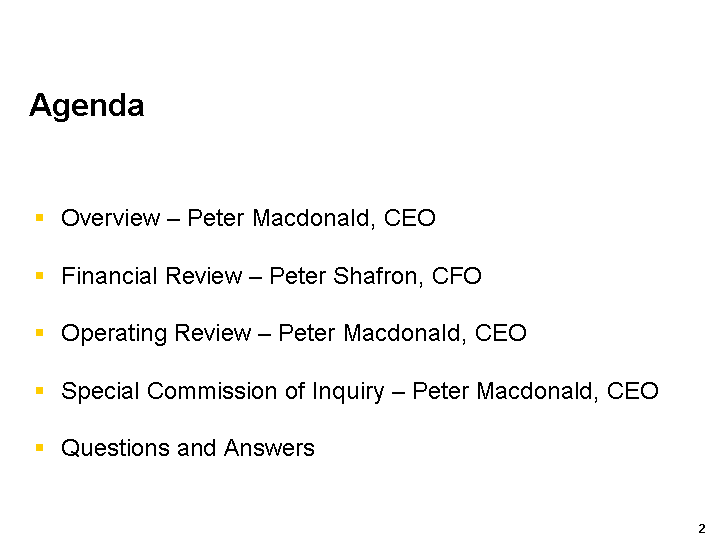
| Overview - Peter Macdonald, CEO Financial Review - Peter Shafron, CFO Operating Review - Peter Macdonald, CEO Special Commission of Inquiry - Peter Macdonald, CEO Questions and Answers Agenda |
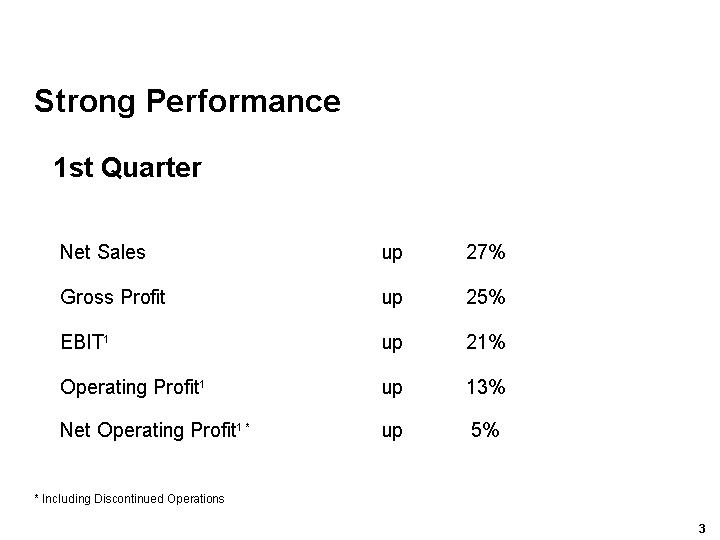
| * Including Discontinued Operations Strong Performance 1st Quarter Net Sales up 27% Gross Profit up 25% EBIT1 up 21% Operating Profit1 up 13% Net Operating Profit1 * up 5% |
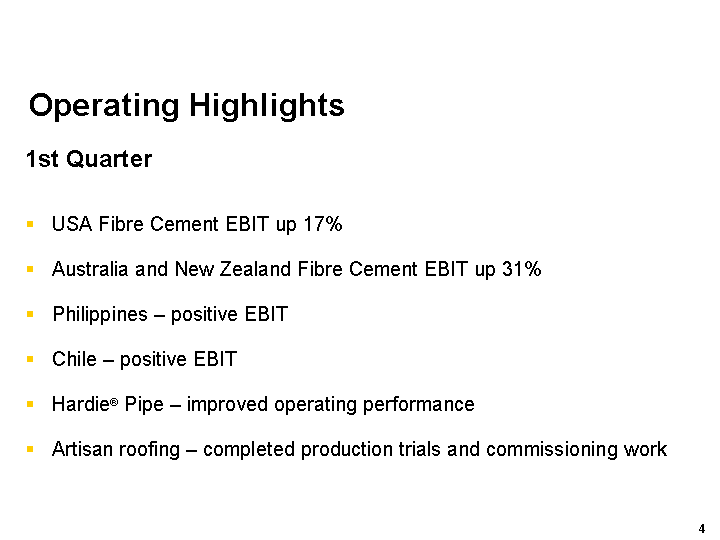
| Operating Highlights 1st Quarter USA Fibre Cement EBIT up 17% Australia and New Zealand Fibre Cement EBIT up 31% Philippines - positive EBIT Chile - positive EBIT Hardie(r) Pipe - improved operating performance Artisan roofing - completed production trials and commissioning work |
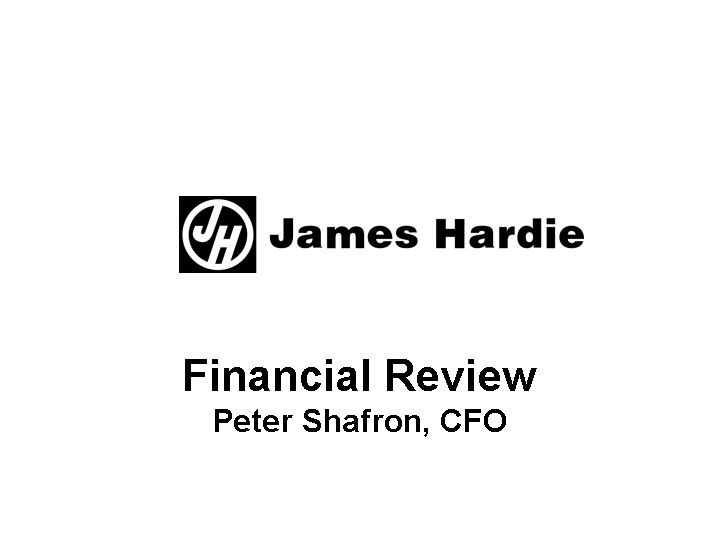
| Financial Review Peter Shafron, CFO |
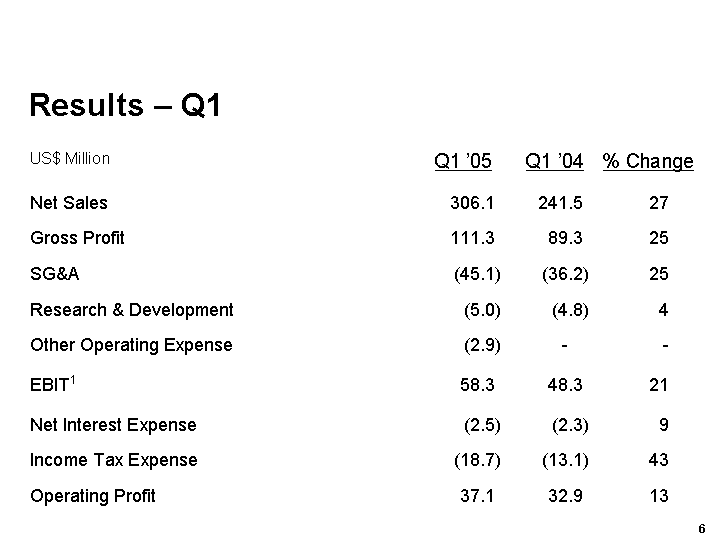
| US$ Million Q1 '05 Q1 '04 % Change Net Sales 306.1 241.5 27 Gross Profit 111.3 89.3 25 SG&A (45.1) (36.2) 25 Research & Development (5.0) (4.8) 4 Other Operating Expense (2.9) - - EBIT1 58.3 48.3 21 Net Interest Expense (2.5) (2.3) 9 Income Tax Expense (18.7) (13.1) 43 Operating Profit 37.1 32.9 13 Results - Q1 |

| Segment Net Sales - Q1 US$ Million Q1 '05 Q1 '04 % Change USA Fibre Cement 240.7 186.8 29 Asia Pacific Fibre Cement 57.3 50.1 14 Other Fibre Cement 8.1 4.6 76 Total 306.1 241.5 27 |

| Segment EBIT1 - Q1 US$ Million Q1 '05 Q1'04 % Change USA Fibre Cement 63.1 54.1 17 Asia Pacific Fibre Cement 12.0 8.6 40 Other Fibre Cement (3.3) (3.7) 11 R & D (4.1) (3.3) (24) Total Segment EBIT 67.7 55.7 22 Corporate Costs (9.4) (7.4) (27) Total EBIT 58.3 48.3 21 R&D includes "core" R&D expenses and administrative expenses, but excludes product development expenses |
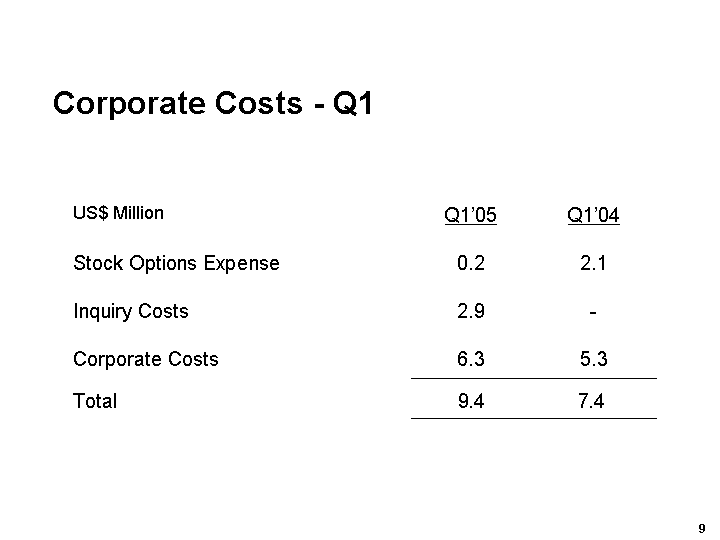
| Corporate Costs - Q1 US$ Million Q1'05 Q1'04 Stock Options Expense 0.2 2.1 Inquiry Costs 2.9 - Corporate Costs 6.3 5.3 Total 9.4 7.4 Total |
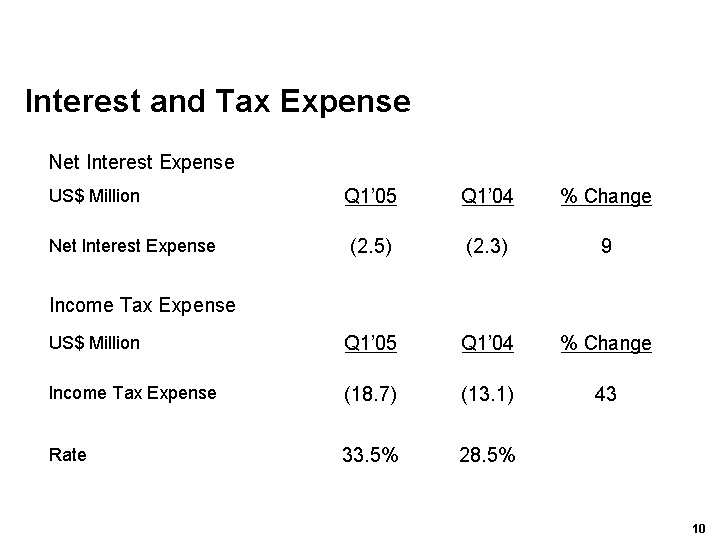
| Interest and Tax Expense Net Interest Expense US$ Million Q1'05 Q1'04 % Change Net Interest Expense (2.5) (2.3) 9 Income Tax Expense US$ Million Q1'05 Q1'04 % Change Income Tax Expense (18.7) (13.1) 43 Rate 33.5% 28.5% |

| EBITDA1 - Q1 Q1'05 Q1'04 % Change EBIT1 USA Fibre Cement Asia Pacific Fibre Cement Other Fibre Cement R & D Corporate 63.1 12.0 (3.3) (4.1) (9.4) 54.1 8.6 (3.7) (3.3) (7.4) 17 40 11 (24) (27) Depreciation and Amortisation USA Fibre Cement Asia Pacific Fibre Cement Other Fibre Cement 5.8 2.4 0.7 4.9 2.3 0.1 18 4 - Total EBITDA 67.2 55.6 21 R&D includes "core" R&D expenses and administrative expenses, but excludes product development expenses |

| Capital Expenditure - Q1 Capital Expenditure Capital Expenditure Depreciation Depreciation US$ Million Q1 '05 Q1 '04 Q1 '05 Q1 '04 USA Fibre Cement 28.5 18.5 5.8 4.9 Asia Pacific Fibre Cement 1.0 1.2 2.4 2.3 Other Fibre Cement 0.8 1.1 0.7 0.1 Total Segments 30.3 20.8 8.9 7.3 |

| Key Ratios Q1'05 FY '04 FY '03 EPS (Diluted) 8.1c 27.2c 18.2c Return on Shareholders Funds* 28.9% 27.6% 42.3% Return on Capital Employed 31.8% 23.4% 20.9% EBIT1/Sales 19.0% 17.5% 16.4% Gearing Ratio1 10.8% 17.0% 21.4% Net Interest Cover 23.3x 17.2x 6.5x * Total Company |
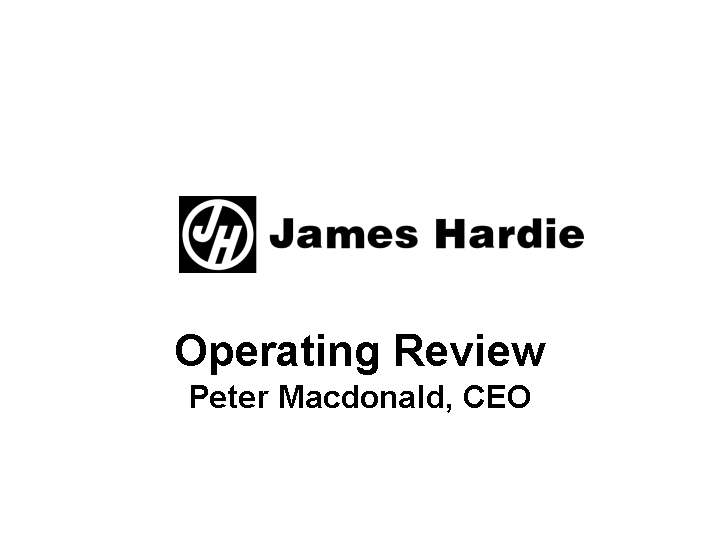
| Operating Review Peter Macdonald, CEO |

| USA Fibre Cement Photographs |

| Strong 1st Quarter Result Net Sales up 29% to US$240.7 million Sales Volume up 27% to 490.4 mmsf1 Average Price up 2% to US$491 per msf1 EBIT1 up 17% to US$63.1 million EBIT Margin1 down 2.8 pts to 26.2% USA Fibre Cement |
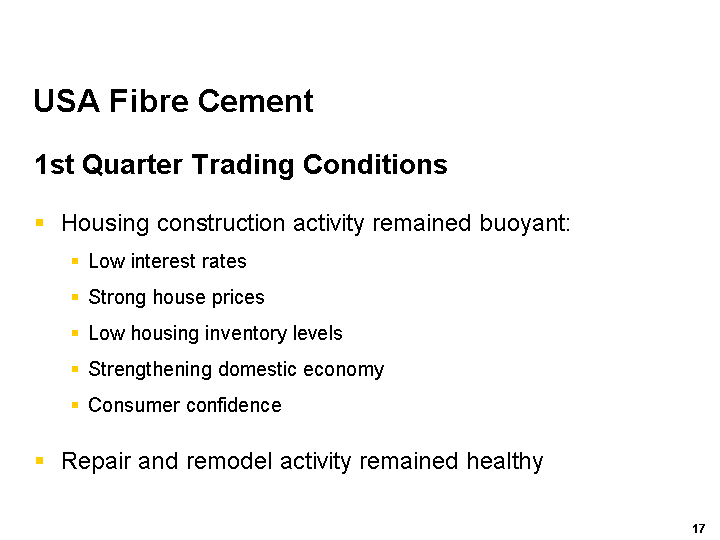
| USA Fibre Cement 1st Quarter Trading Conditions Housing construction activity remained buoyant: Low interest rates Strong house prices Low housing inventory levels Strengthening domestic economy Consumer confidence Repair and remodel activity remained healthy |
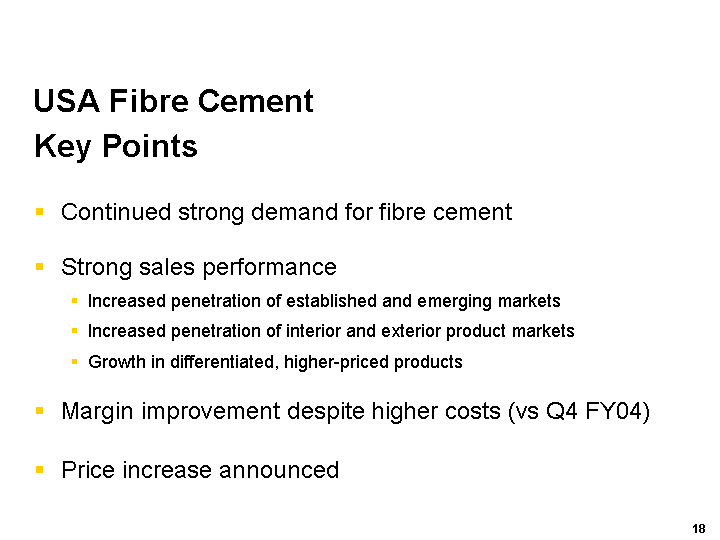
| USA Fibre Cement Key Points Continued strong demand for fibre cement Strong sales performance Increased penetration of established and emerging markets Increased penetration of interior and exterior product markets Growth in differentiated, higher-priced products Margin improvement despite higher costs (vs Q4 FY04) Price increase announced |
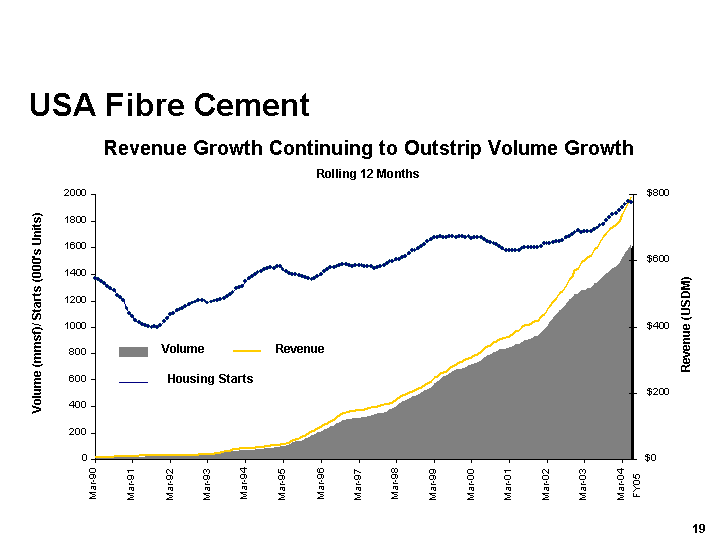
| USA Fibre Cement Revenue Growth Continuing to Outstrip Volume Growth Rolling 12 Months FY05 0 200 400 600 800 1000 1200 1400 1600 1800 2000 Mar-90 Mar-91 Mar-92 Mar-93 Mar-94 Mar-95 Mar-96 Mar-97 Mar-98 Mar-99 Mar-00 Mar-01 Mar-02 Mar-03 Mar-04 Volume (mmsf)/ Starts (000's Units) $0 $200 $400 $600 $800 Revenue (USDM) Volume Revenue Housing Starts |
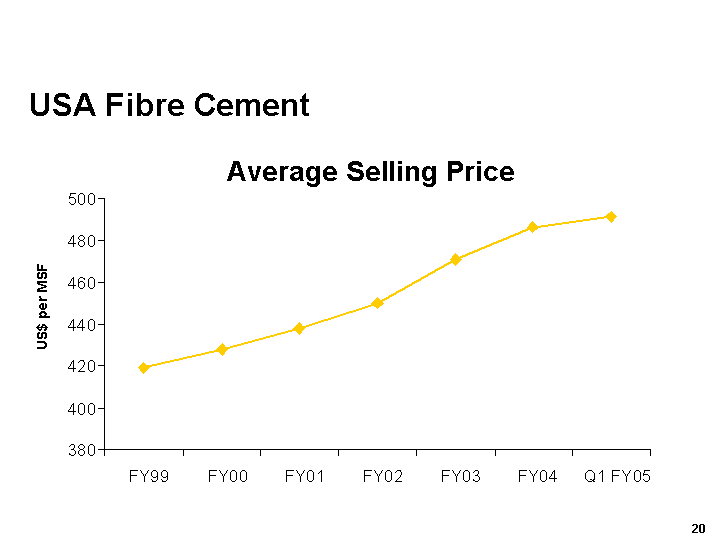
| USA Fibre Cement Average Selling Price US$ per MSF US$ per MSF 380 400 420 440 460 480 500 FY99 FY00 FY01 FY02 FY03 FY04 Q1 FY05 |
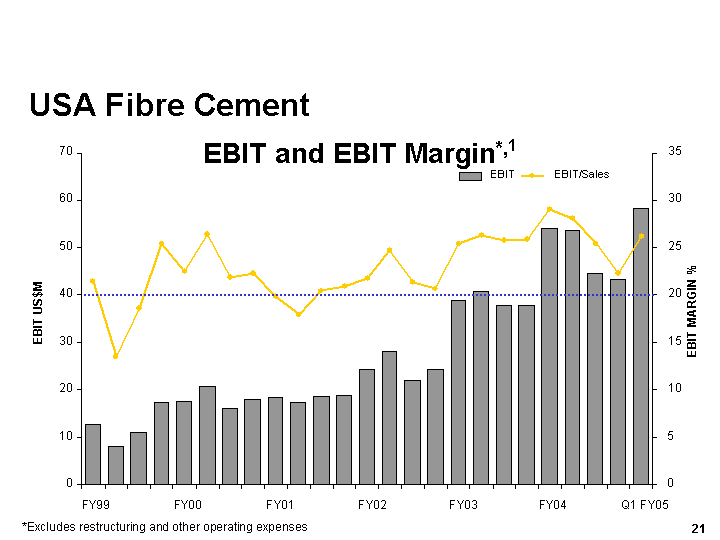
| USA Fibre Cement *Excludes restructuring and other operating expenses EBIT and EBIT Margin*,1 0 10 20 30 40 50 60 70 FY99 FY00 FY01 FY02 FY03 FY04 Q1 FY05 EBIT US$M 0 5 10 15 20 25 30 35 EBIT MARGIN % EBIT EBIT/Sales |

| USA Fibre Cement Strategy Aggressively grow market for fibre cement Grow our overall market position while defending our share in existing market segments Offer products with superior value to that of our competitors, introducing differentiated products to reduce direct price competition |
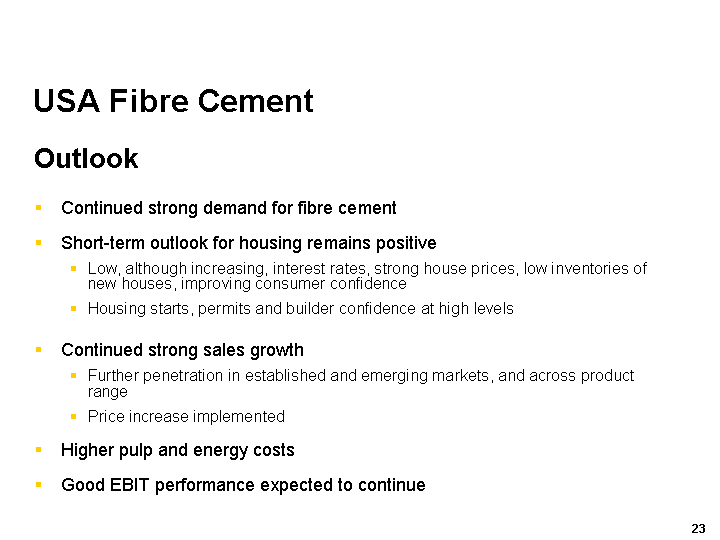
| USA Fibre Cement Outlook Continued strong demand for fibre cement Short-term outlook for housing remains positive Low, although increasing, interest rates, strong house prices, low inventories of new houses, improving consumer confidence Housing starts, permits and builder confidence at high levels Continued strong sales growth Further penetration in established and emerging markets, and across product range Price increase implemented Higher pulp and energy costs Good EBIT performance expected to continue |

| Asia Pacific Fibre Cement Photographs |
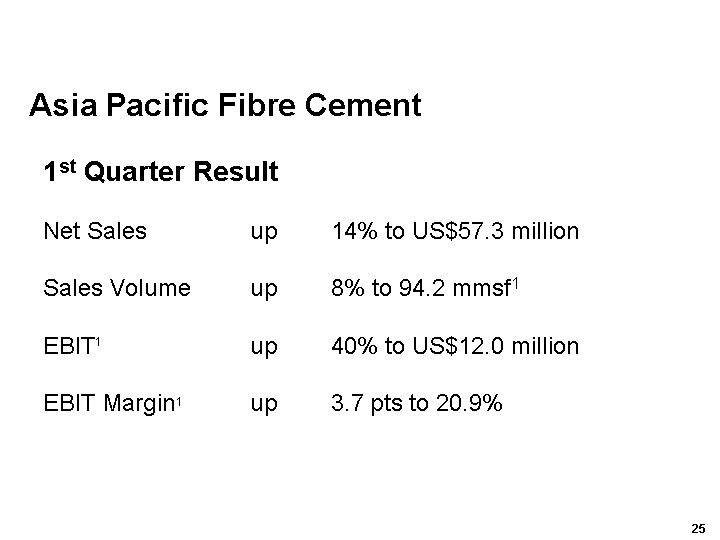
| Asia Pacific Fibre Cement 1st Quarter Result Net Sales up 14% to US$57.3 million Sales Volume up 8% to 94.2 mmsf1 EBIT1 up 40% to US$12.0 million EBIT Margin1 up 3.7 pts to 20.9% |
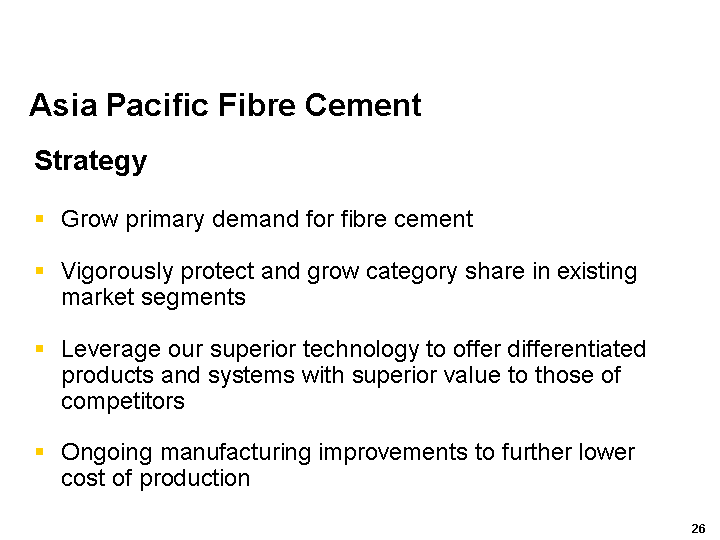
| Strategy Grow primary demand for fibre cement Vigorously protect and grow category share in existing market segments Leverage our superior technology to offer differentiated products and systems with superior value to those of competitors Ongoing manufacturing improvements to further lower cost of production Asia Pacific Fibre Cement |
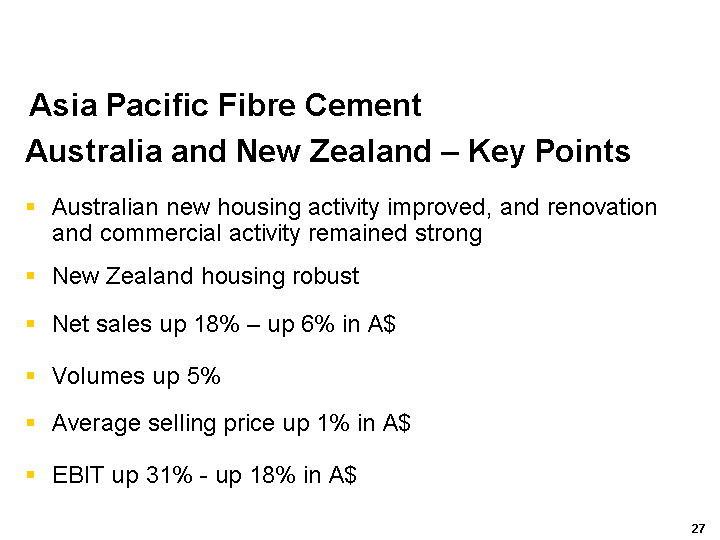
| Australia and New Zealand - Key Points Australian new housing activity improved, and renovation and commercial activity remained strong New Zealand housing robust Net sales up 18% - up 6% in A$ Volumes up 5% Average selling price up 1% in A$ EBIT up 31% - up 18% in A$ Asia Pacific Fibre Cement |
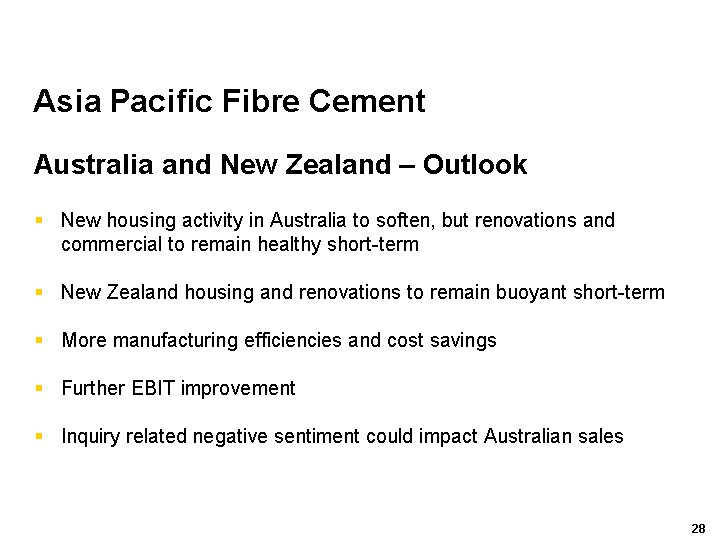
| Asia Pacific Fibre Cement Australia and New Zealand - Outlook New housing activity in Australia to soften, but renovations and commercial to remain healthy short-term New Zealand housing and renovations to remain buoyant short-term More manufacturing efficiencies and cost savings Further EBIT improvement Inquiry related negative sentiment could impact Australian sales |
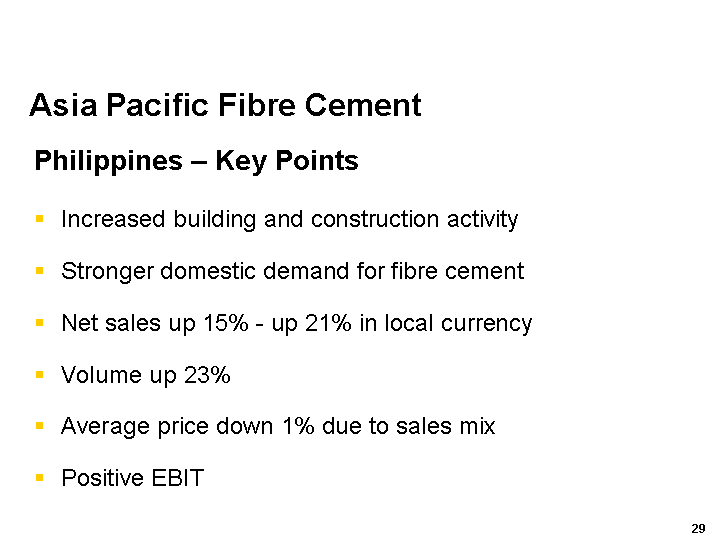
| Asia Pacific Fibre Cement Philippines - Key Points Increased building and construction activity Stronger domestic demand for fibre cement Net sales up 15% - up 21% in local currency Volume up 23% Average price down 1% due to sales mix Positive EBIT |
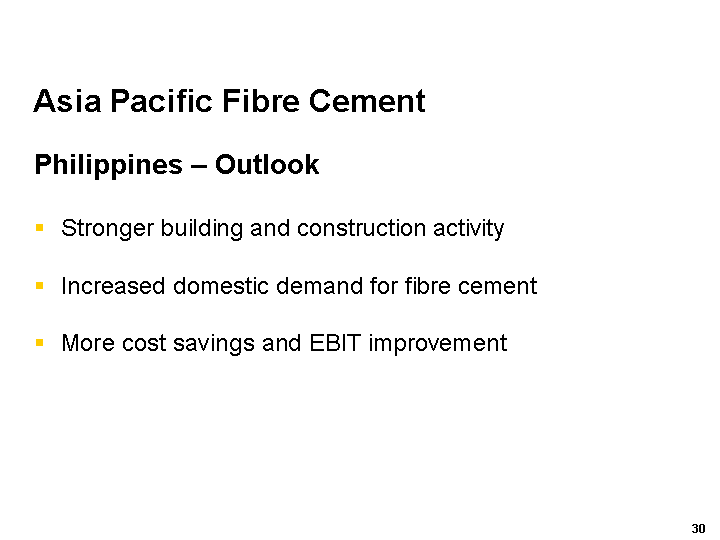
| Asia Pacific Fibre Cement Philippines - Outlook Stronger building and construction activity Increased domestic demand for fibre cement More cost savings and EBIT improvement |
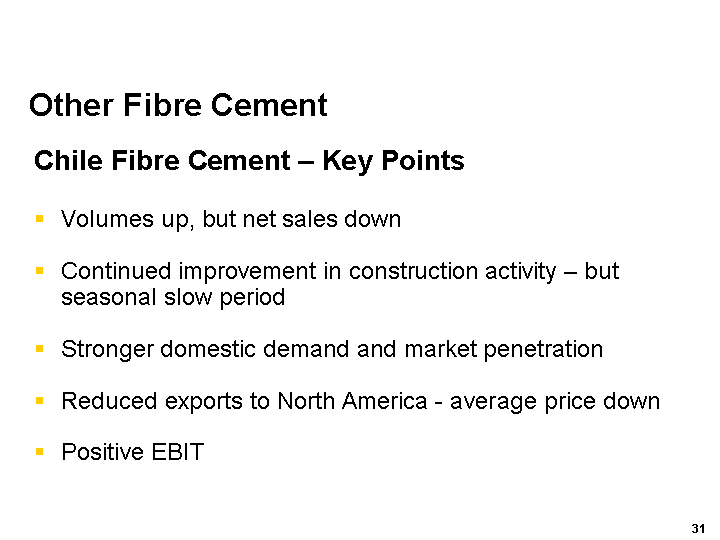
| Other Fibre Cement Chile Fibre Cement - Key Points Volumes up, but net sales down Continued improvement in construction activity - but seasonal slow period Stronger domestic demand and market penetration Reduced exports to North America - average price down Positive EBIT |
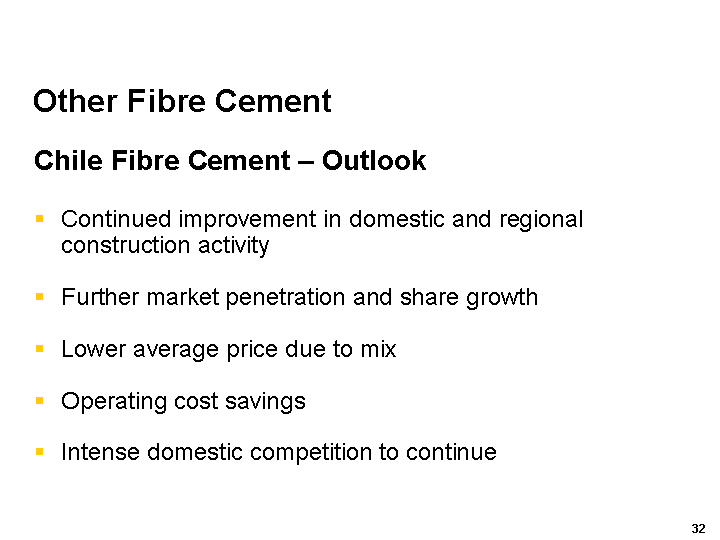
| Other Fibre Cement Chile Fibre Cement - Outlook Continued improvement in domestic and regional construction activity Further market penetration and share growth Lower average price due to mix Operating cost savings Intense domestic competition to continue |

| Other Fibre Cement USA Hardie(r) Pipe - Key Points Net sales more than doubled Continued penetration of Florida, USA market Higher prices Further manufacturing performance and cost improvements Smaller EBIT loss |
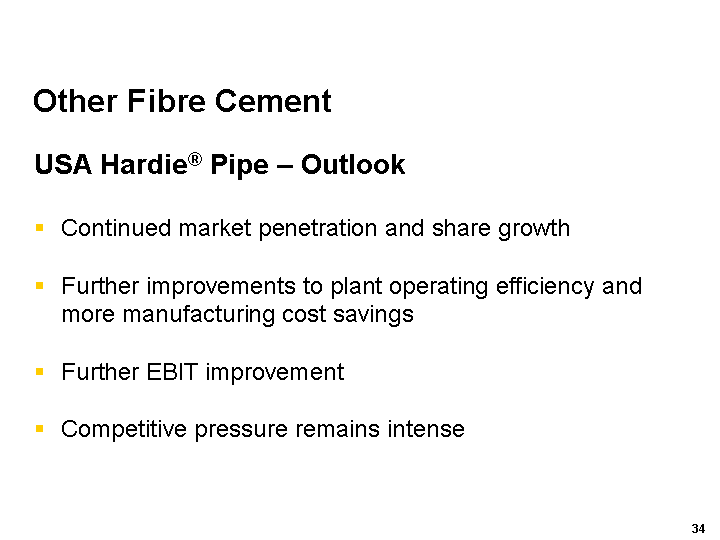
| Other Fibre Cement USA Hardie(r) Pipe - Outlook Continued market penetration and share growth Further improvements to plant operating efficiency and more manufacturing cost savings Further EBIT improvement Competitive pressure remains intense |
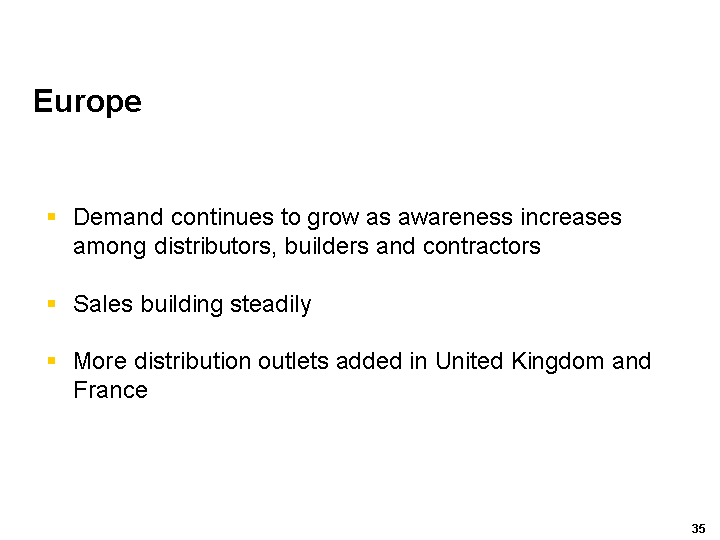
| Europe Demand continues to grow as awareness increases among distributors, builders and contractors Sales building steadily More distribution outlets added in United Kingdom and France |
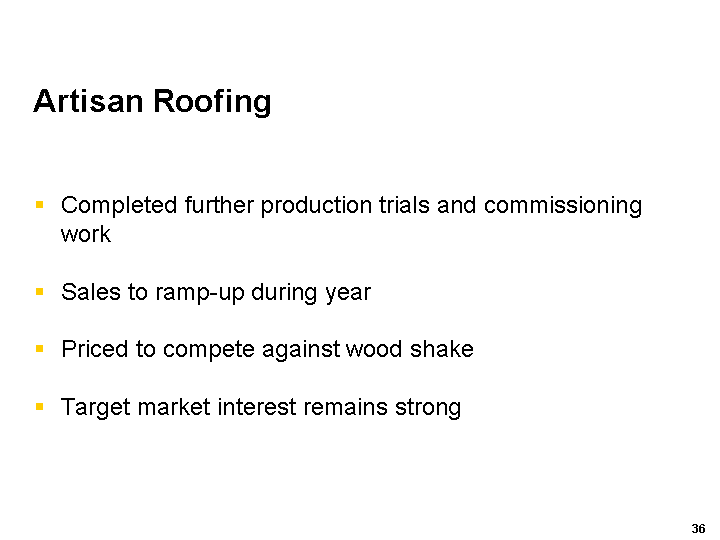
| Artisan Roofing Completed further production trials and commissioning work Sales to ramp-up during year Priced to compete against wood shake Target market interest remains strong |

| Research and Development Key driver of growth Core projects engineered raw materials product formulations engineering and process technologies lightweight and durable products for all climates Sustainable competitive advantage continuing to be built |
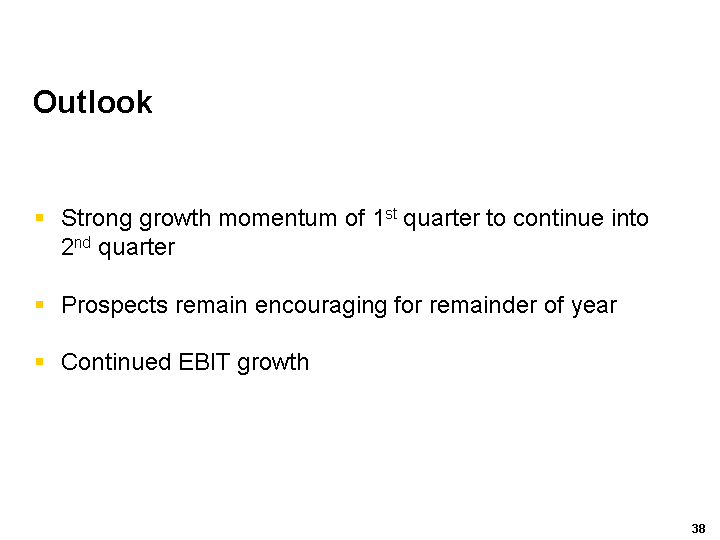
| Outlook Strong growth momentum of 1st quarter to continue into 2nd quarter Prospects remain encouraging for remainder of year Continued EBIT growth |
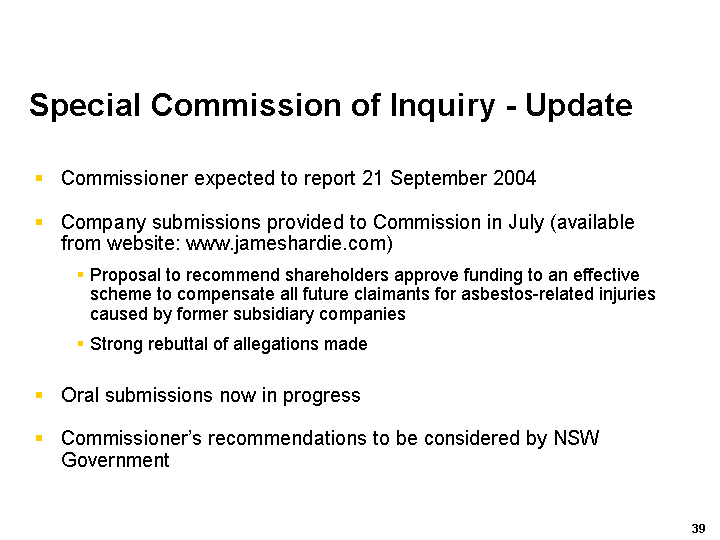
| Special Commission of Inquiry - Update Commissioner expected to report 21 September 2004 Company submissions provided to Commission in July (available from website: www.jameshardie.com) Proposal to recommend shareholders approve funding to an effective scheme to compensate all future claimants for asbestos-related injuries caused by former subsidiary companies Strong rebuttal of allegations made Oral submissions now in progress Commissioner's recommendations to be considered by NSW Government |
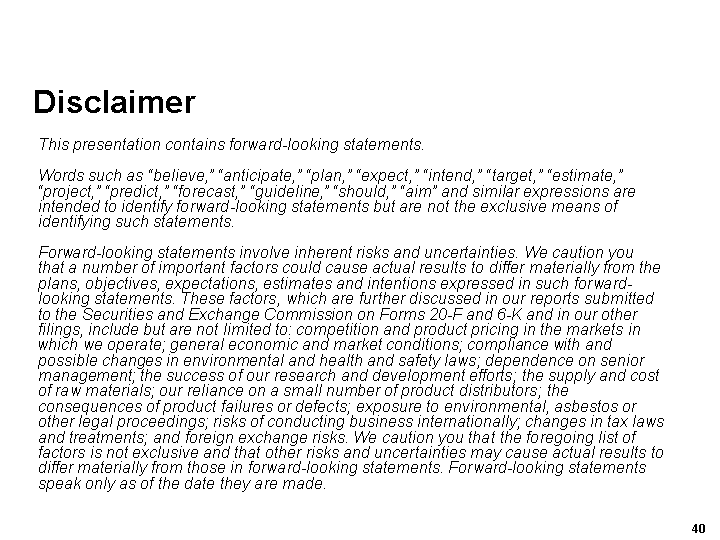
| Disclaimer This presentation contains forward-looking statements. Words such as "believe," "anticipate," "plan," "expect," "intend," "target," "estimate," "project," "predict," "forecast," "guideline," "should," "aim" and similar expressions are intended to identify forward-looking statements but are not the exclusive means of identifying such statements. Forward-looking statements involve inherent risks and uncertainties. We caution you that a number of important factors could cause actual results to differ materially from the plans, objectives, expectations, estimates and intentions expressed in such forward- looking statements. These factors, which are further discussed in our reports submitted to the Securities and Exchange Commission on Forms 20-F and 6-K and in our other filings, include but are not limited to: competition and product pricing in the markets in which we operate; general economic and market conditions; compliance with and possible changes in environmental and health and safety laws; dependence on senior management; the success of our research and development efforts; the supply and cost of raw materials; our reliance on a small number of product distributors; the consequences of product failures or defects; exposure to environmental, asbestos or other legal proceedings; risks of conducting business internationally; changes in tax laws and treatments; and foreign exchange risks. We caution you that the foregoing list of factors is not exclusive and that other risks and uncertainties may cause actual results to differ materially from those in forward-looking statements. Forward-looking statements speak only as of the date they are made. |
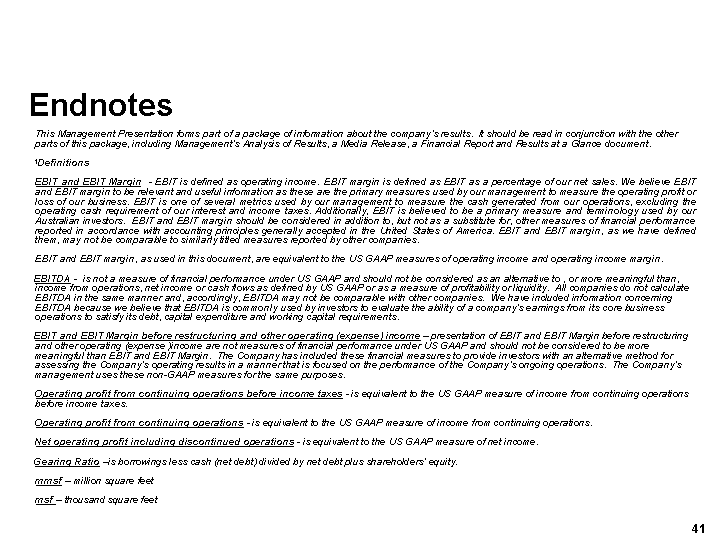
| Endnotes This Management Presentation forms part of a package of information about the company's results. It should be read in conjunction with the other parts of this package, including Management's Analysis of Results, a Media Release, a Financial Report and Results at a Glance document. 1Definitions EBIT and EBIT Margin - EBIT is defined as operating income. EBIT margin is defined as EBIT as a percentage of our net sales. We believe EBIT and EBIT margin to be relevant and useful information as these are the primary measures used by our management to measure the operating profit or loss of our business. EBIT is one of several metrics used by our management to measure the cash generated from our operations, excluding the operating cash requirement of our interest and income taxes. Additionally, EBIT is believed to be a primary measure and terminology used by our Australian investors. EBIT and EBIT margin should be considered in addition to, but not as a substitute for, other measures of financial performance reported in accordance with accounting principles generally accepted in the United States of America. EBIT and EBIT margin, as we have defined them, may not be comparable to similarly titled measures reported by other companies. EBIT and EBIT margin, as used in this document, are equivalent to the US GAAP measures of operating income and operating income margin. EBITDA - is not a measure of financial performance under US GAAP and should not be considered as an alternative to , or more meaningful than, income from operations, net income or cash flows as defined by US GAAP or as a measure of profitability or liquidity. All companies do not calculate EBITDA in the same manner and, accordingly, EBITDA may not be comparable with other companies. We have included information concerning EBITDA because we believe that EBITDA is commonly used by investors to evaluate the ability of a company's earnings from its core business operations to satisfy its debt, capital expenditure and working capital requirements. EBIT and EBIT Margin before restructuring and other operating (expense) income - presentation of EBIT and EBIT Margin before restructuring and other operating (expense )income are not measures of financial performance under US GAAP and should not be considered to be more meaningful than EBIT and EBIT Margin. The Company has included these financial measures to provide investors with an alternative method for assessing the Company's operating results in a manner that is focused on the performance of the Company's ongoing operations. The Company's management uses these non-GAAP measures for the same purposes. Operating profit from continuing operations before income taxes - is equivalent to the US GAAP measure of income from continuing operations before income taxes. Operating profit from continuing operations - is equivalent to the US GAAP measure of income from continuing operations. Net operating profit including discontinued operations - is equivalent to the US GAAP measure of net income. Gearing Ratio -is borrowings less cash (net debt) divided by net debt plus shareholders' equity. mmsf - million square feet msf - thousand square feet |
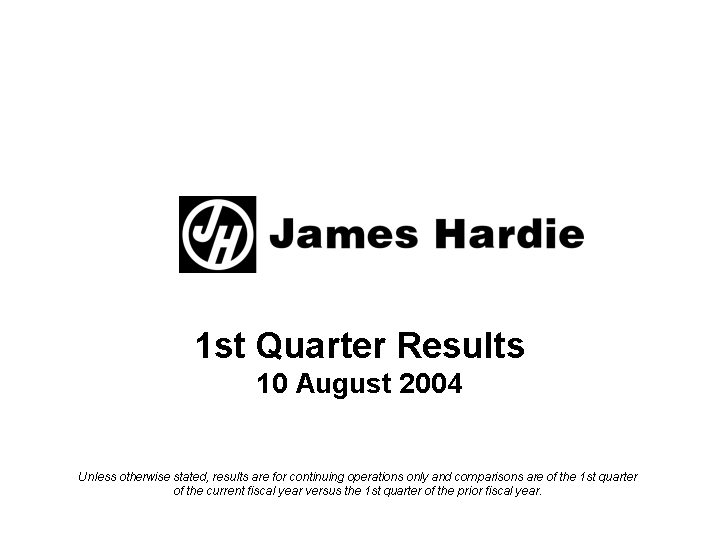
| 1st Quarter Results 10 August 2004 Unless otherwise stated, results are for continuing operations only and comparisons are of the 1st quarter of the current fiscal year versus the 1st quarter of the prior fiscal year. |